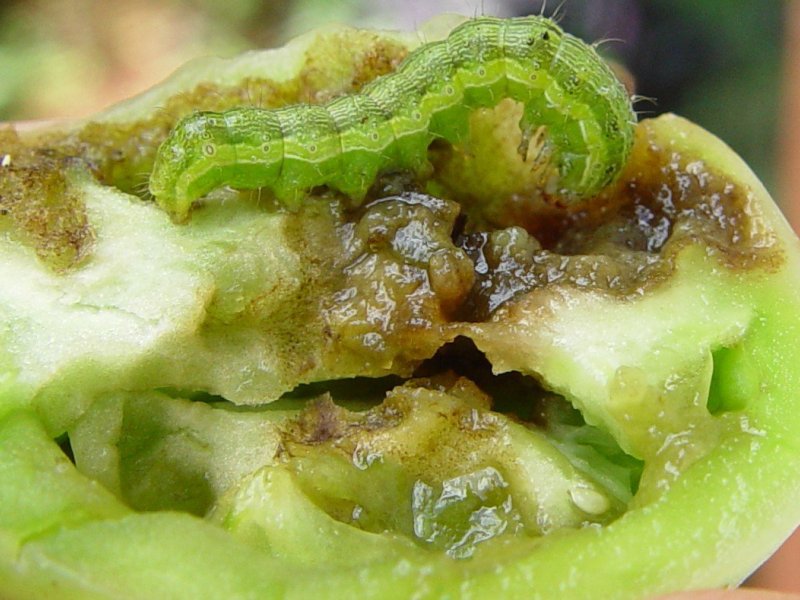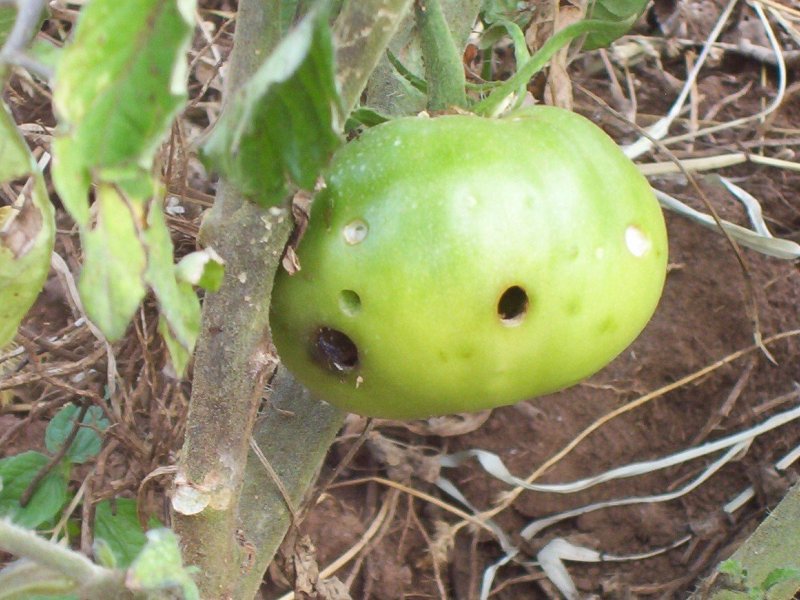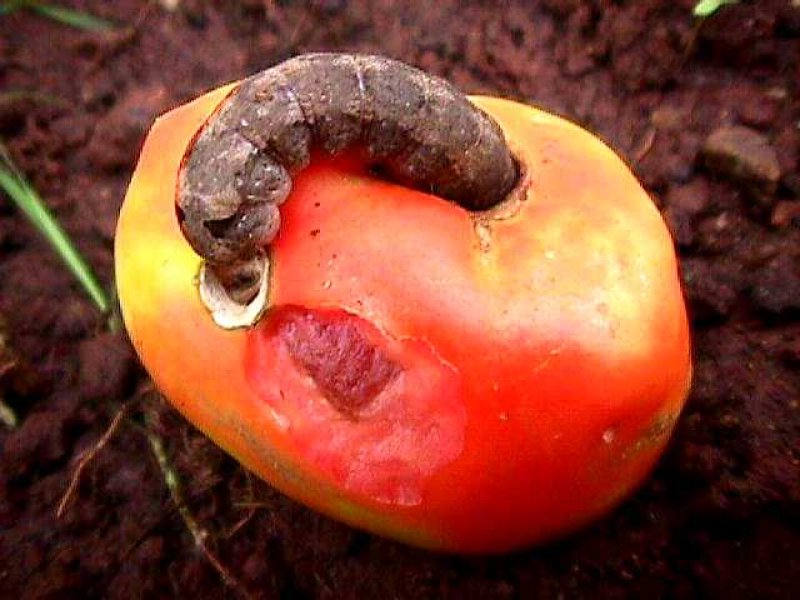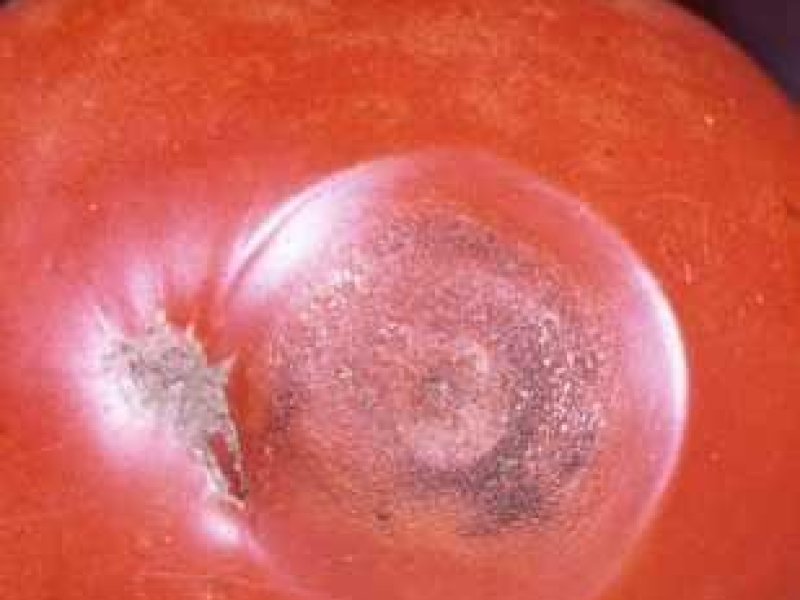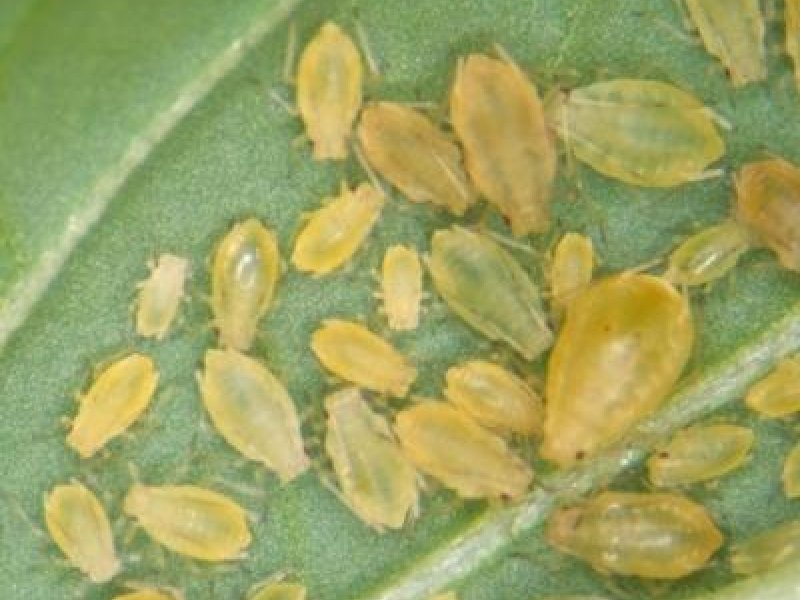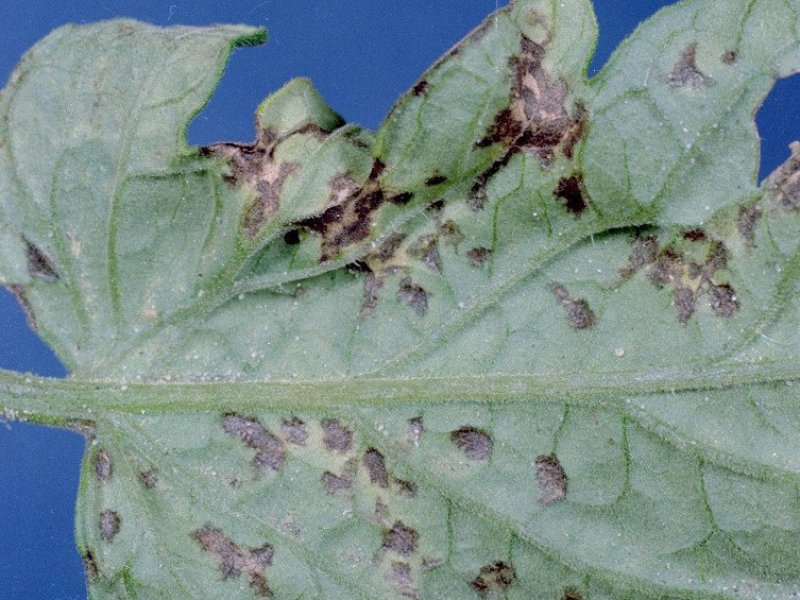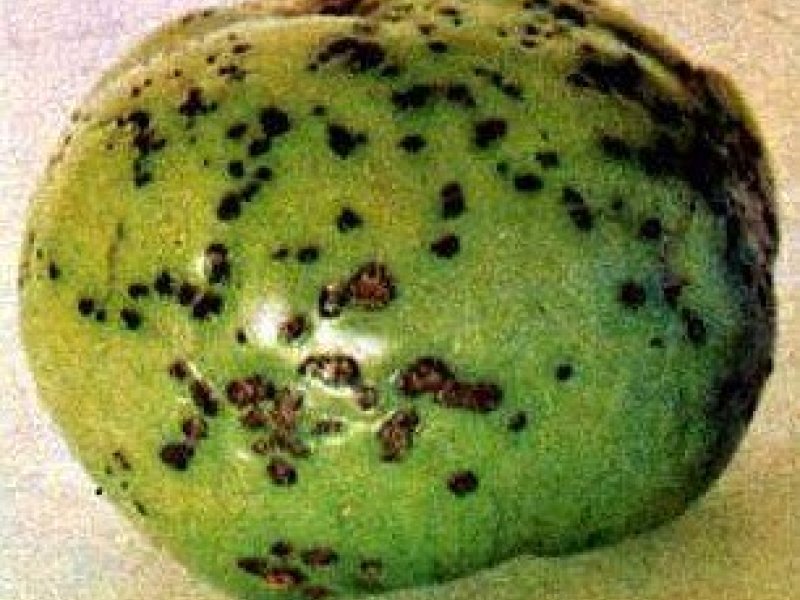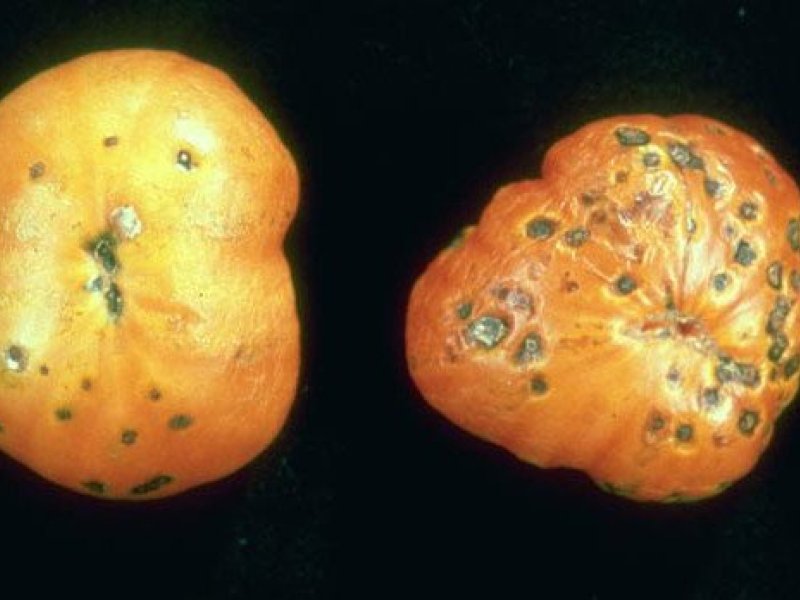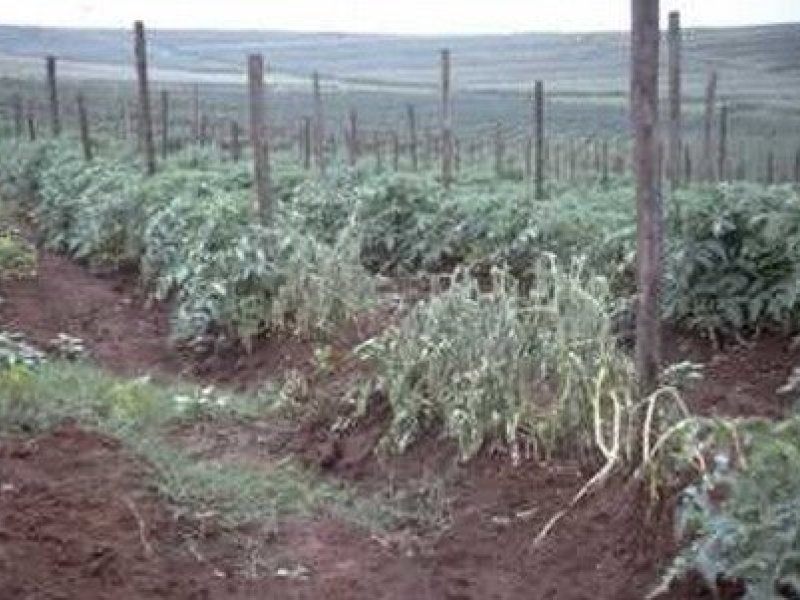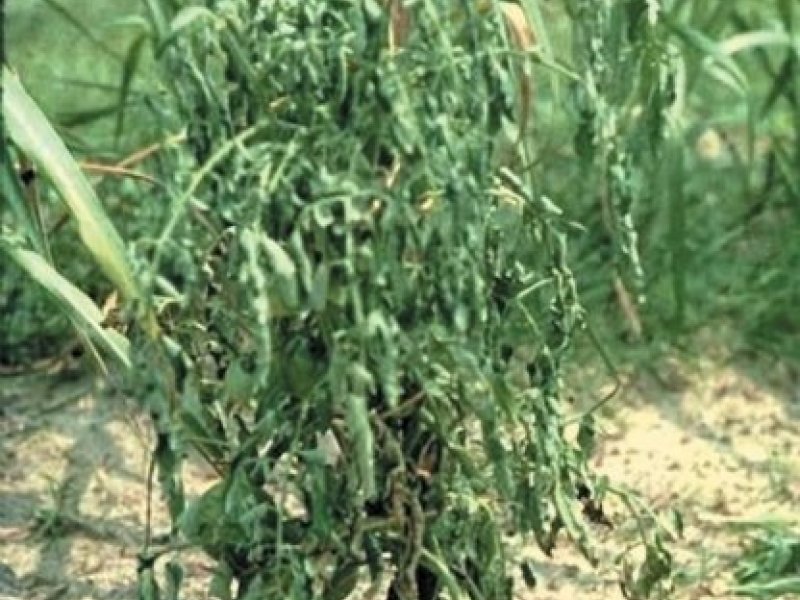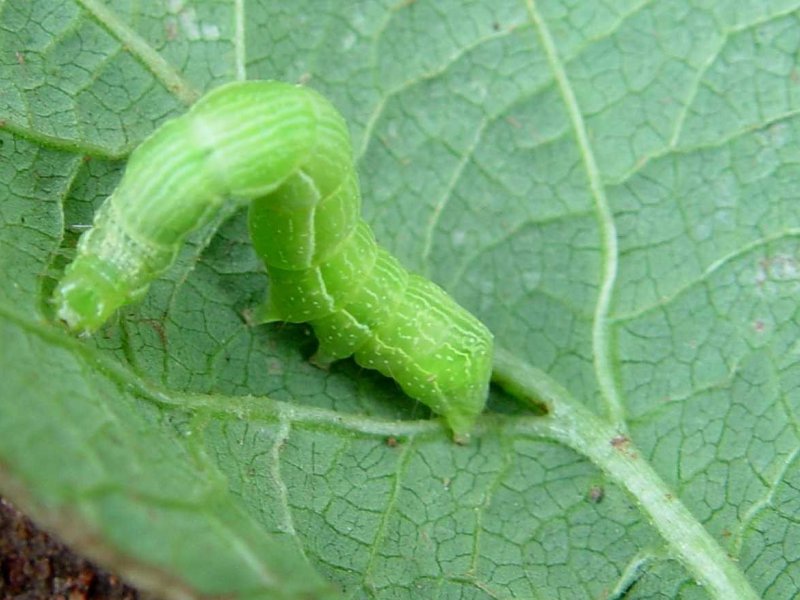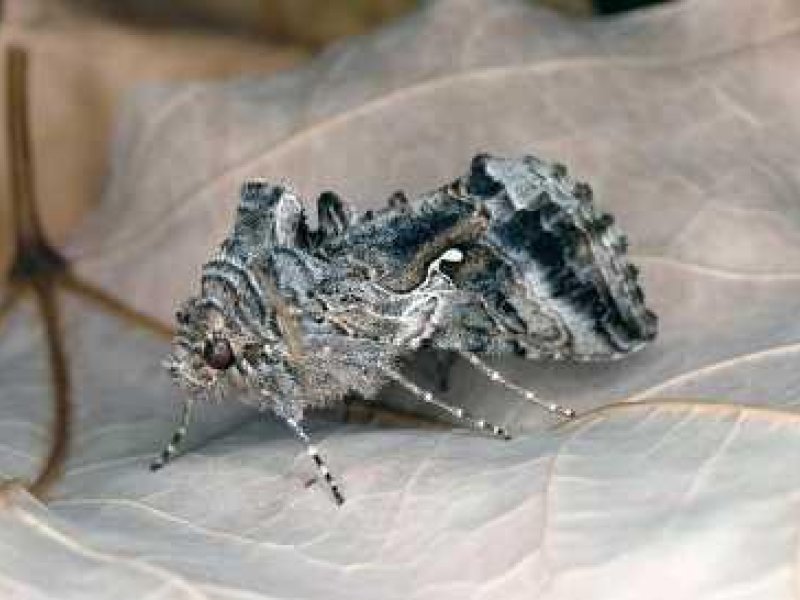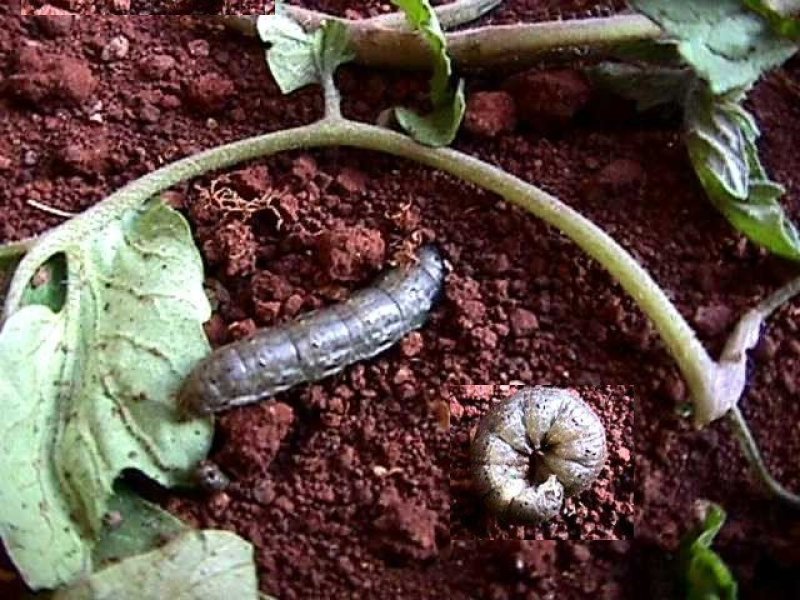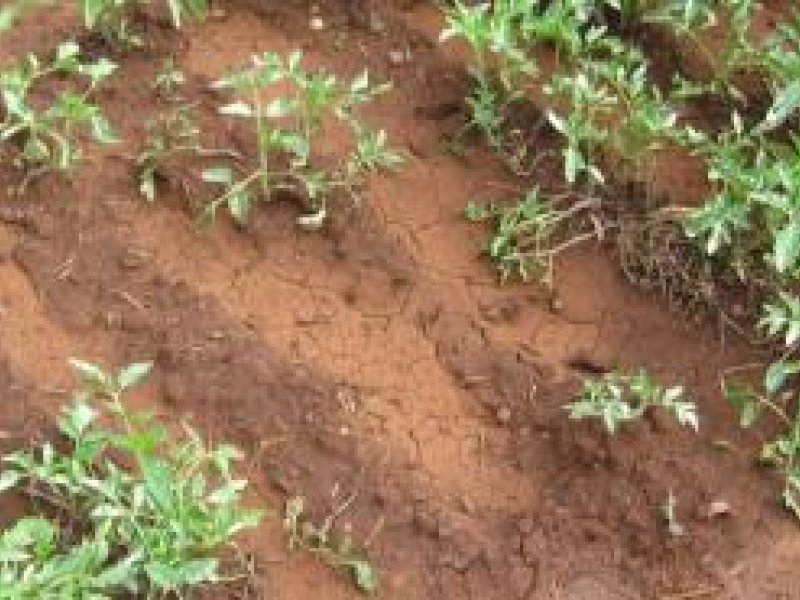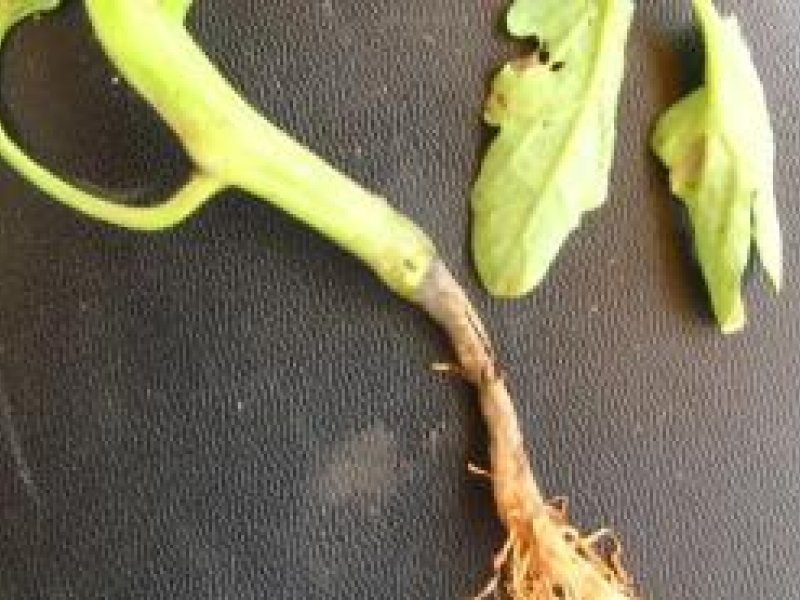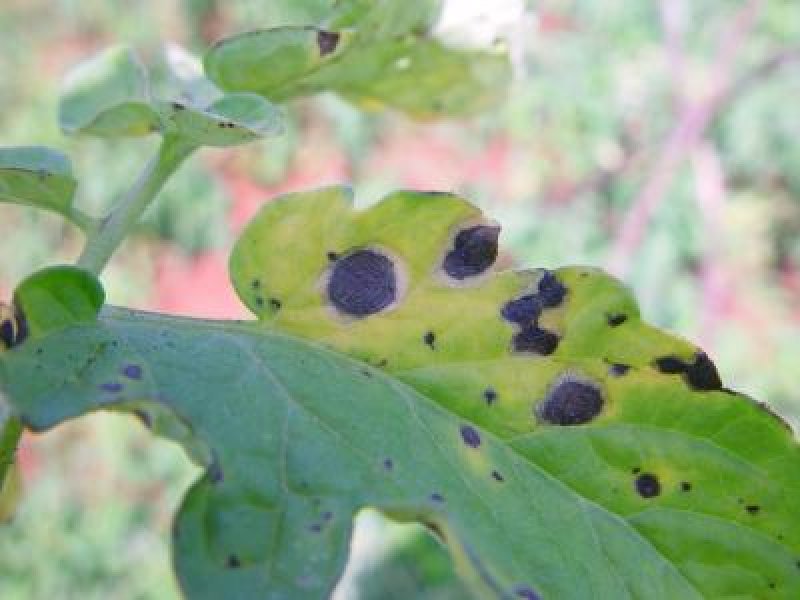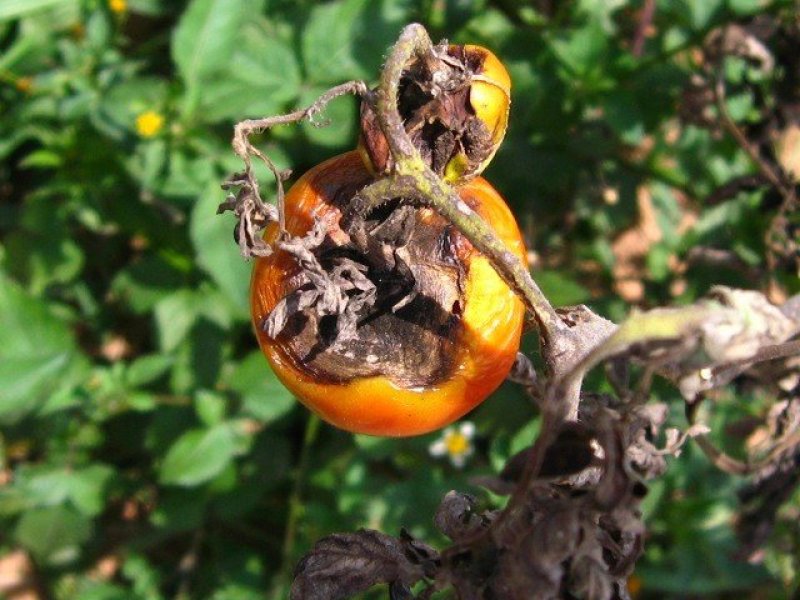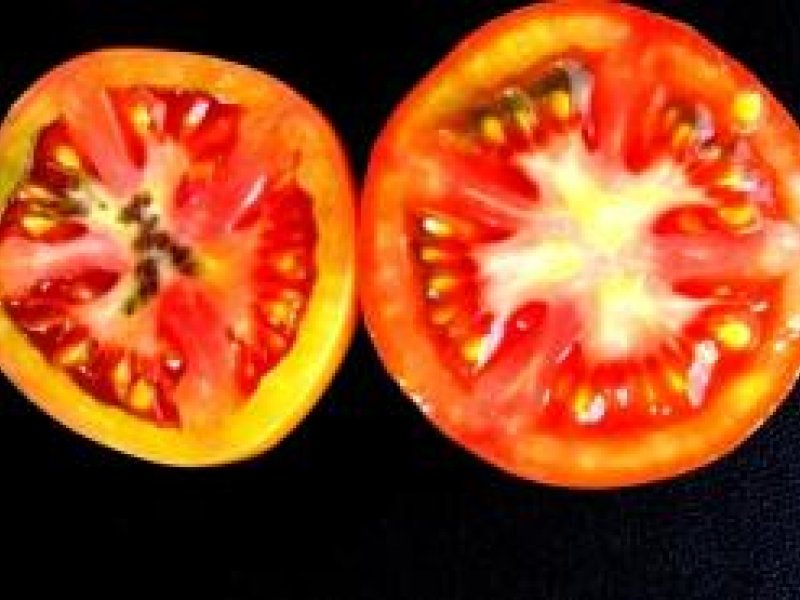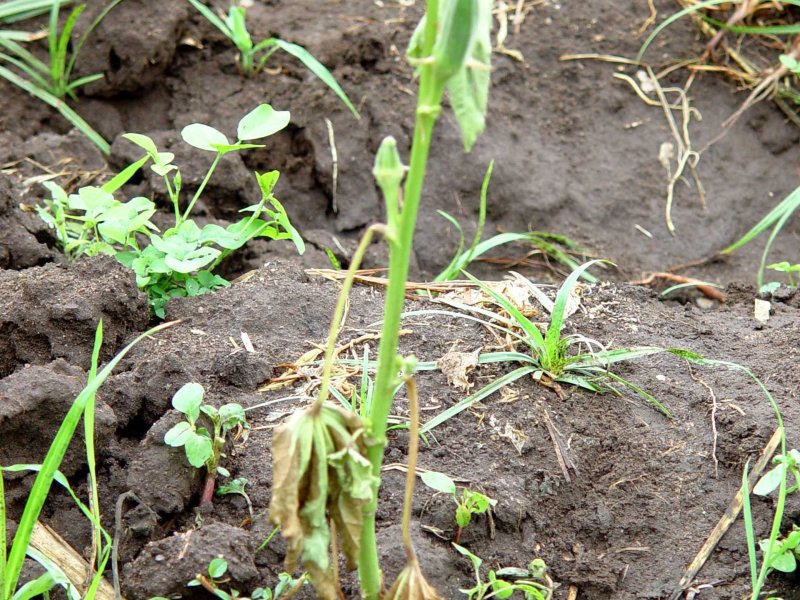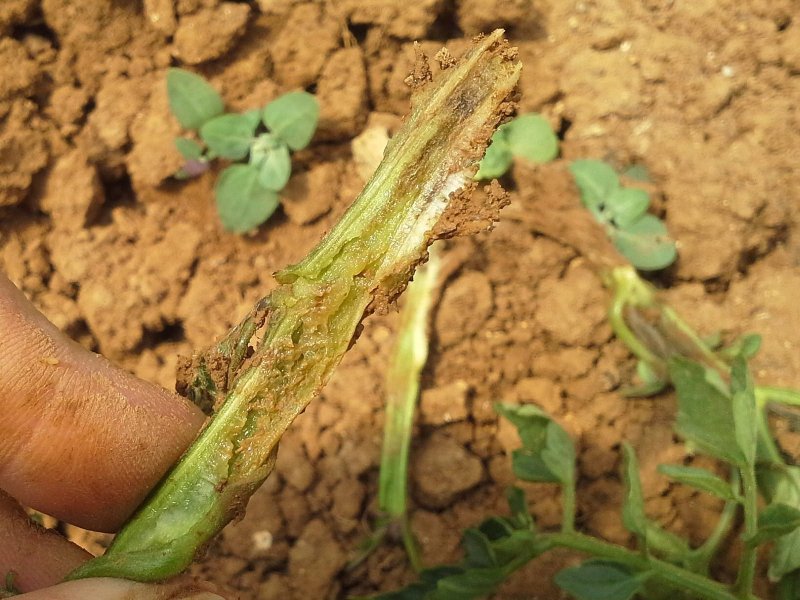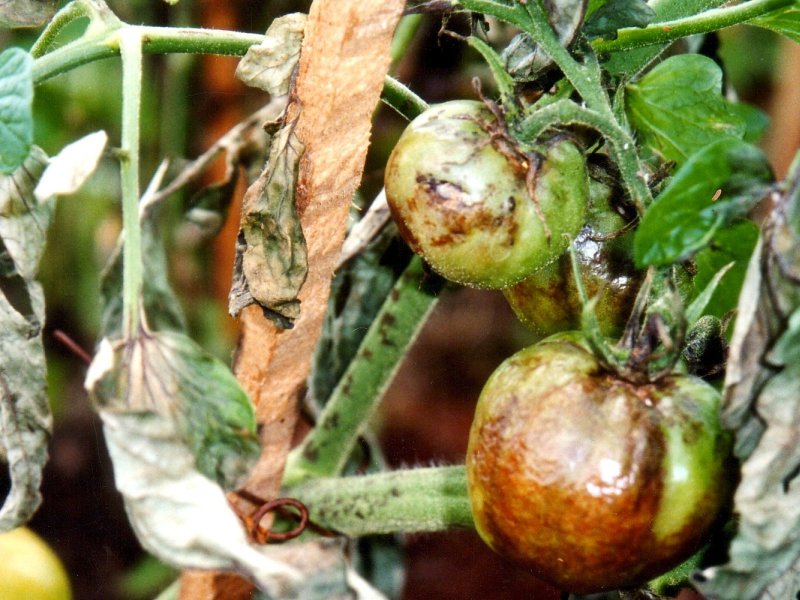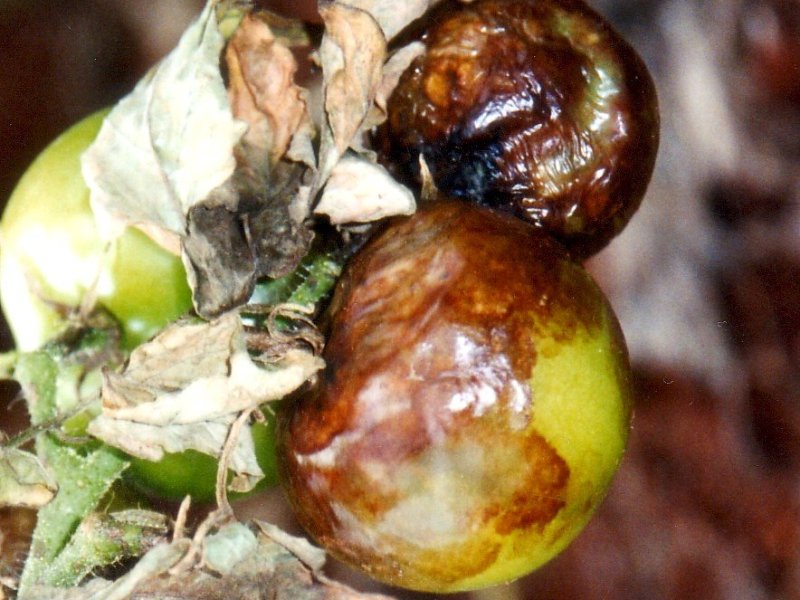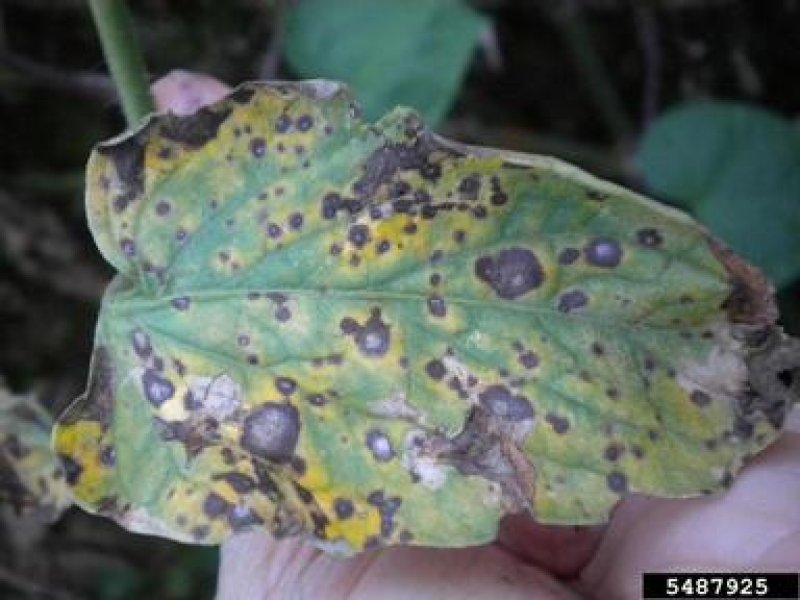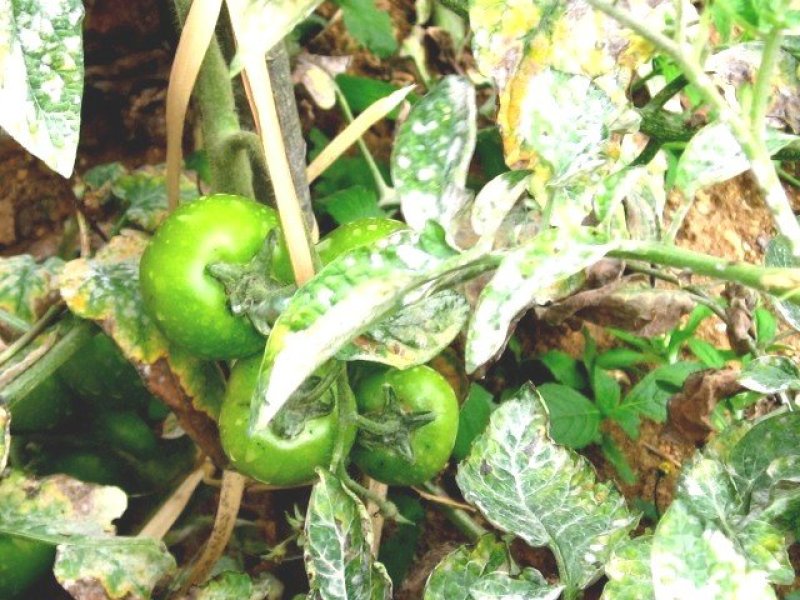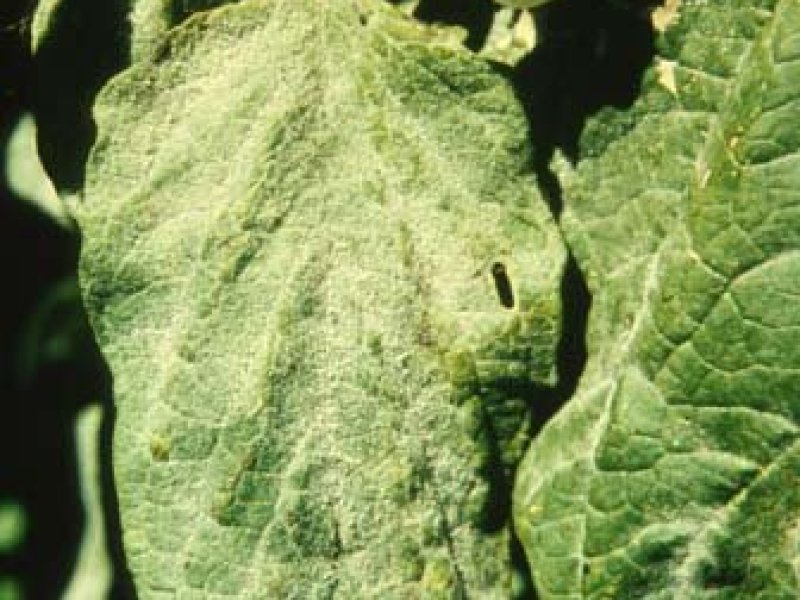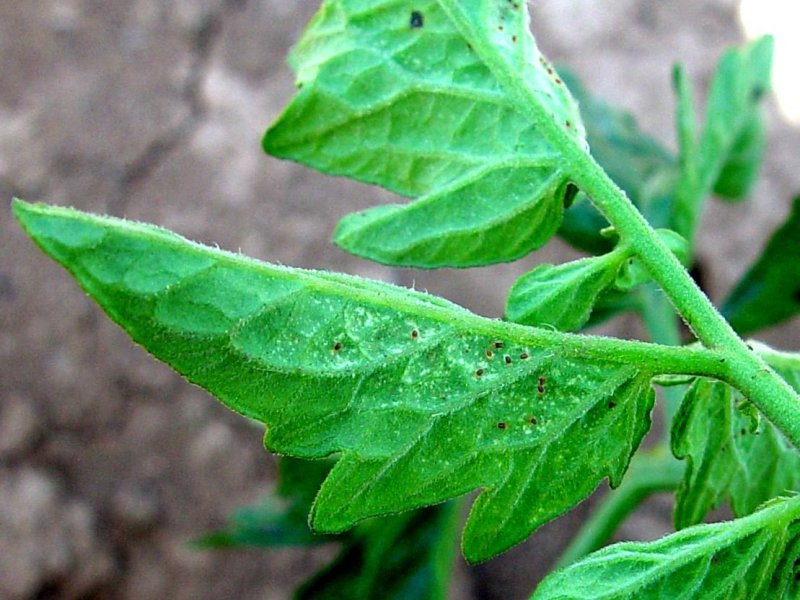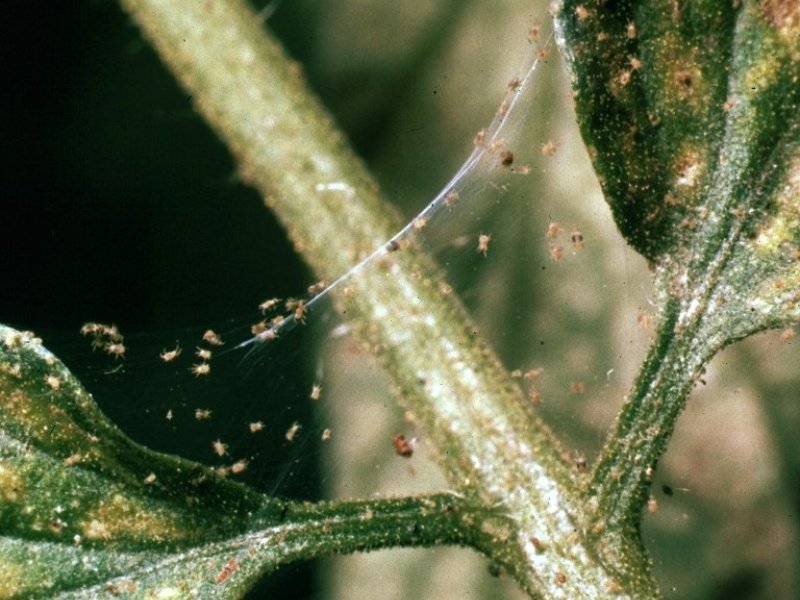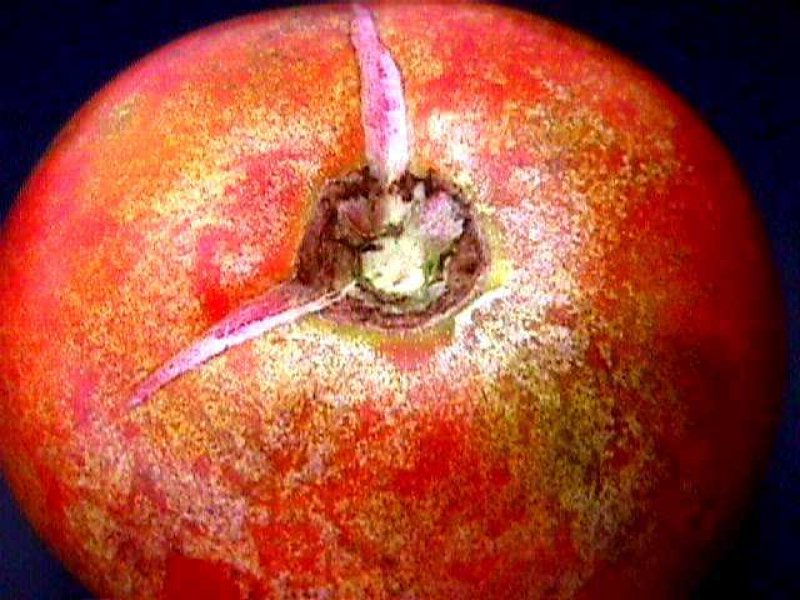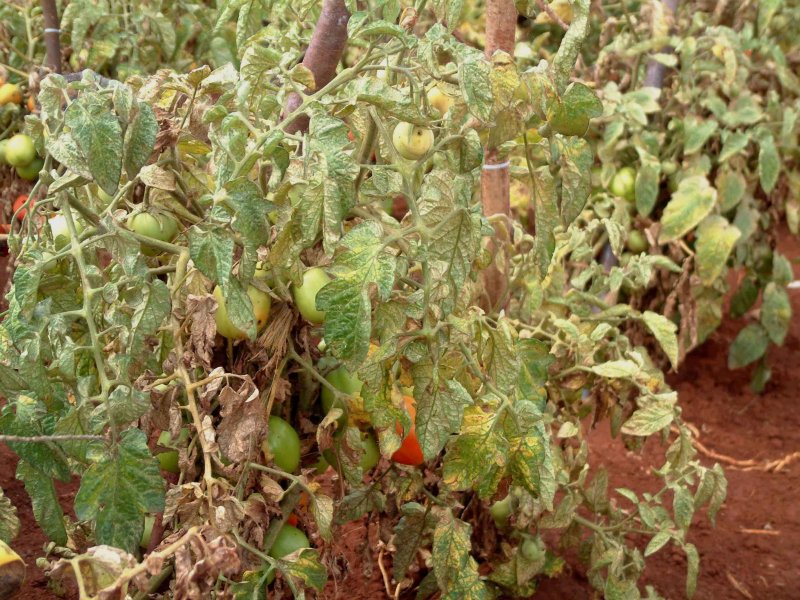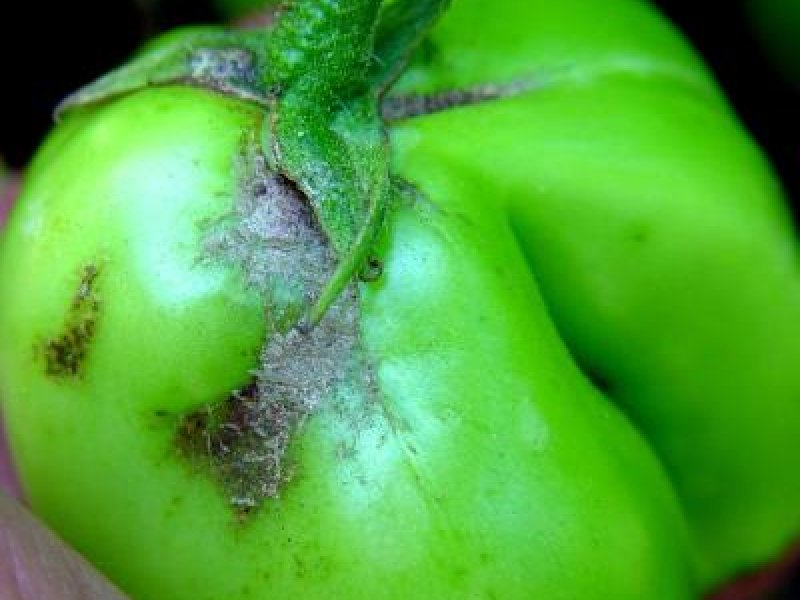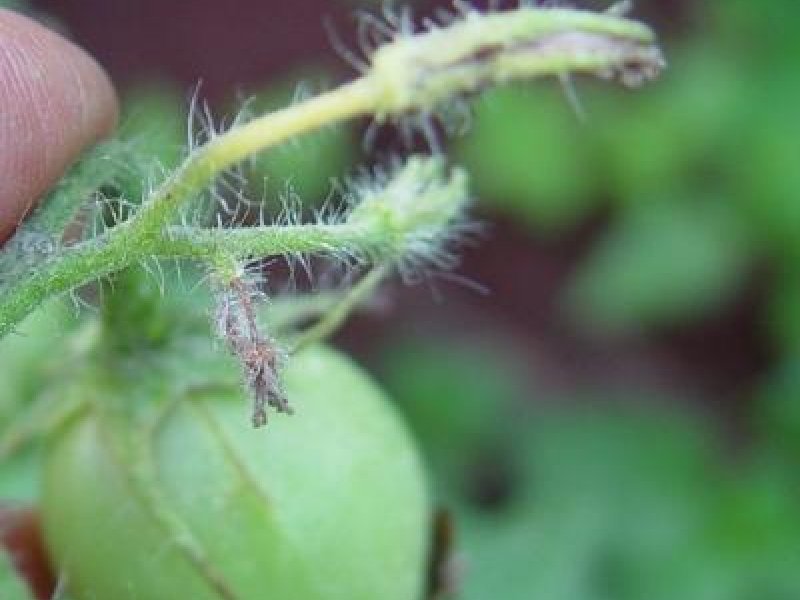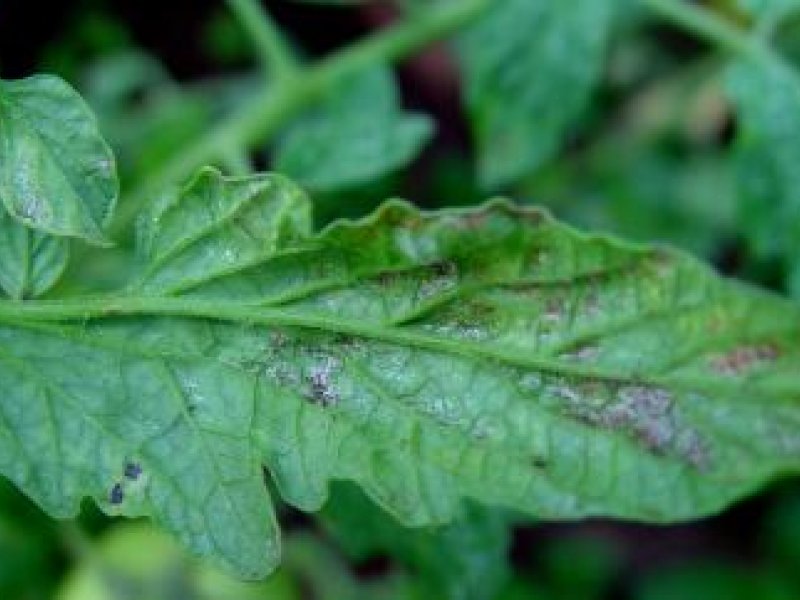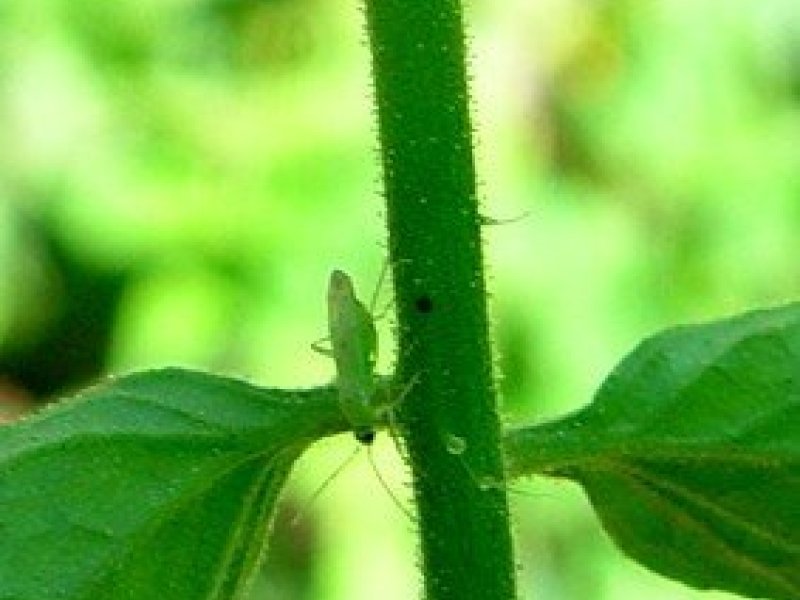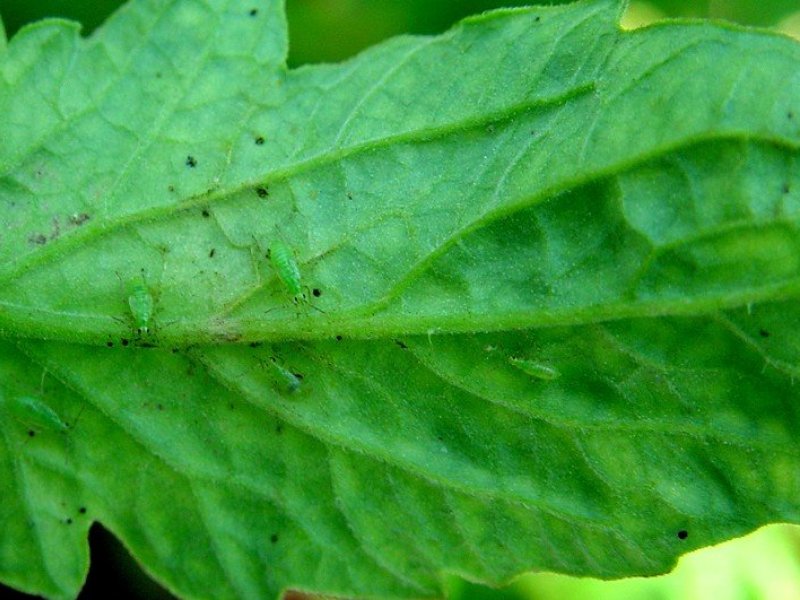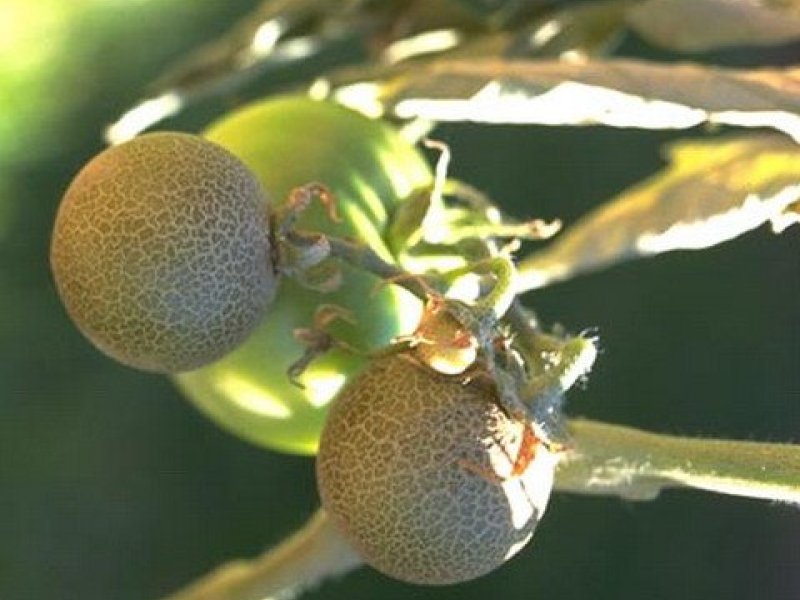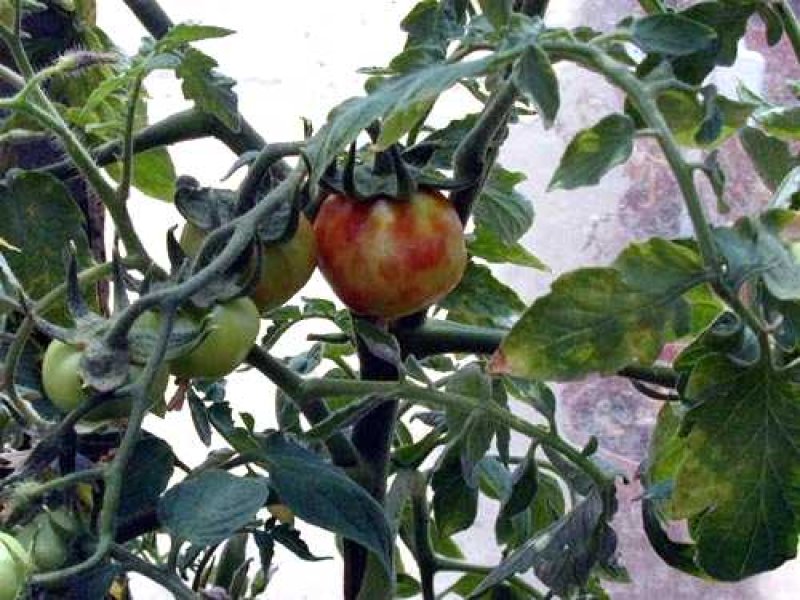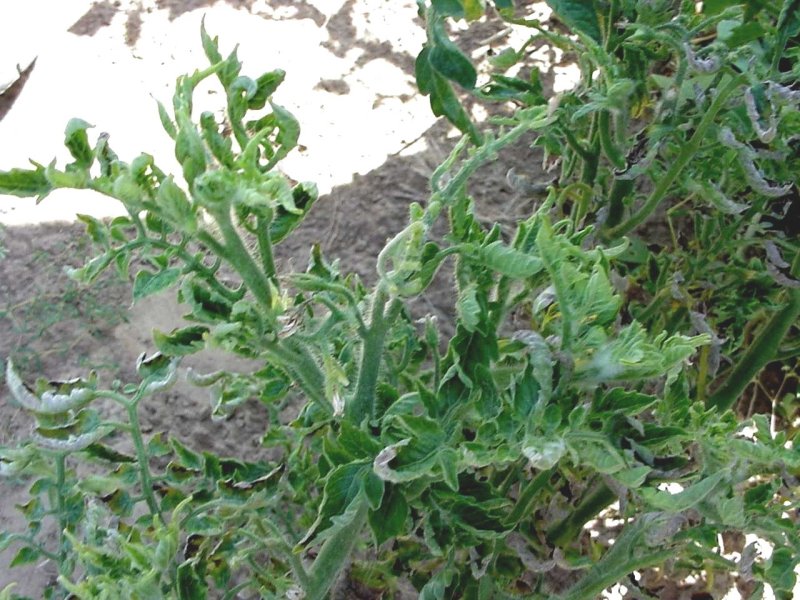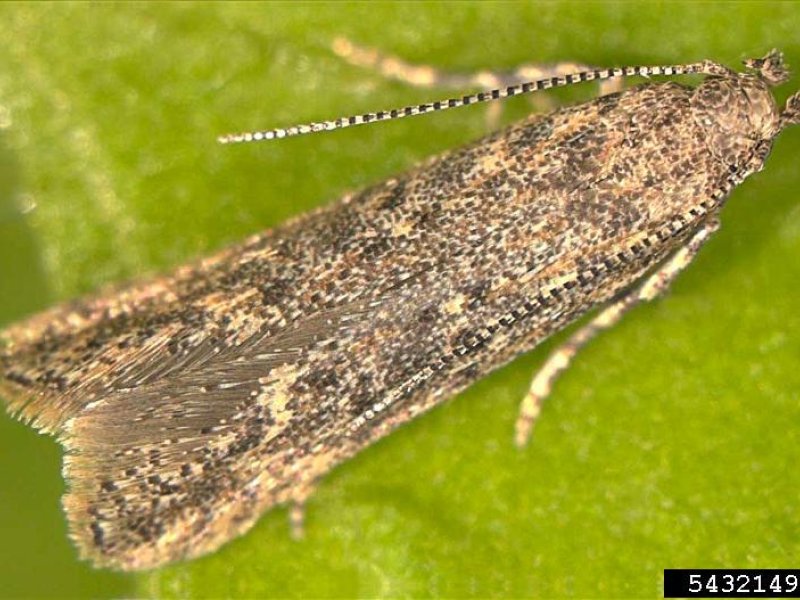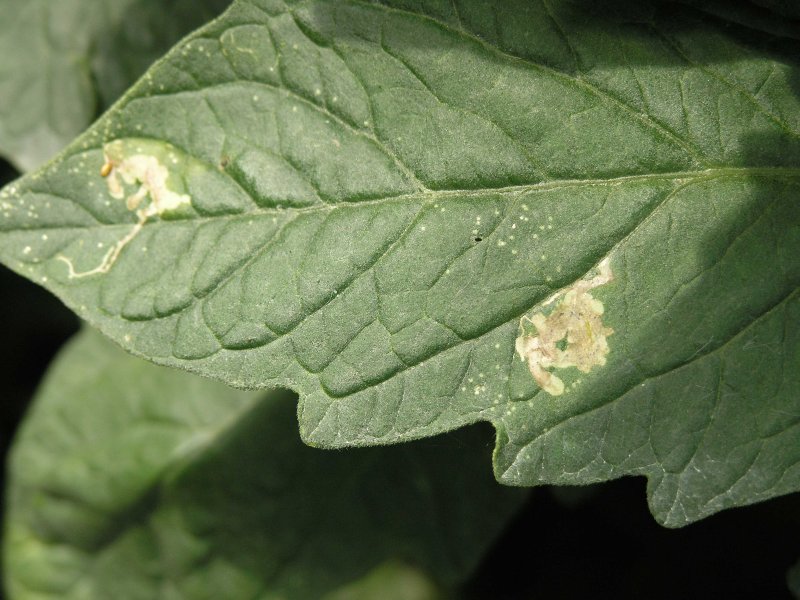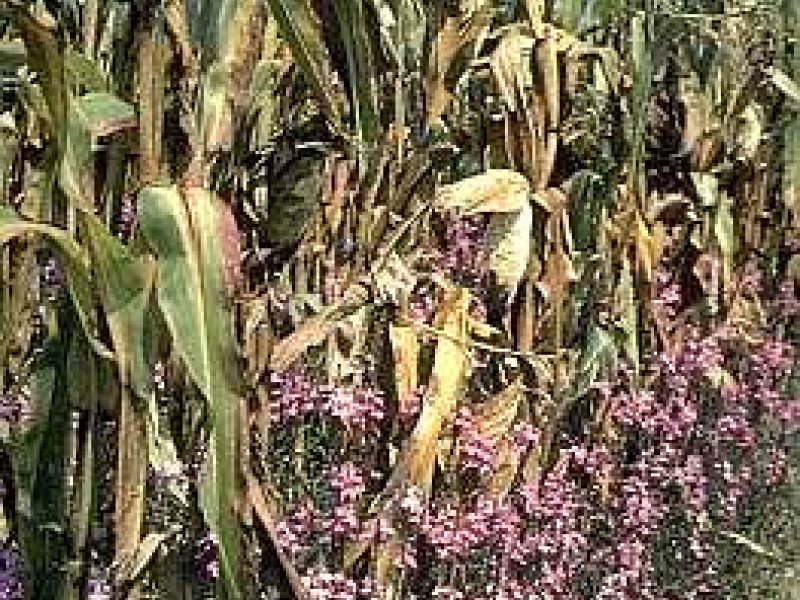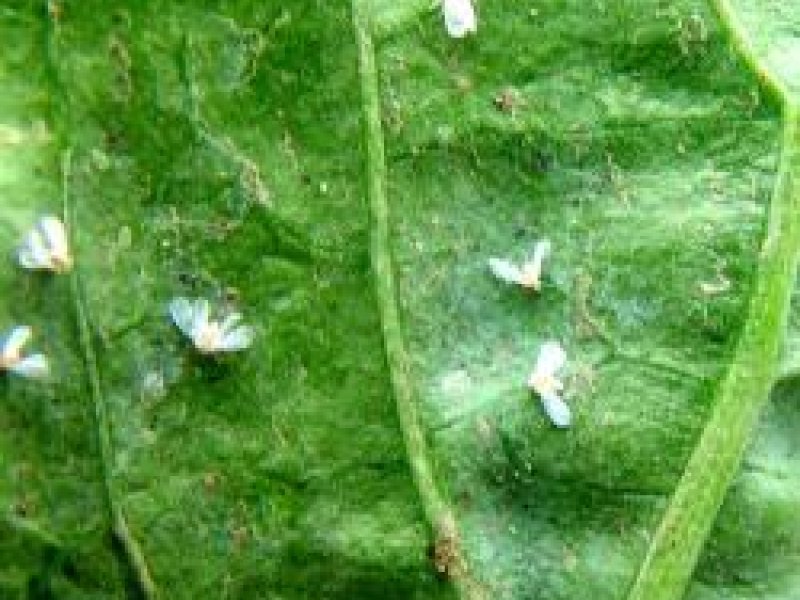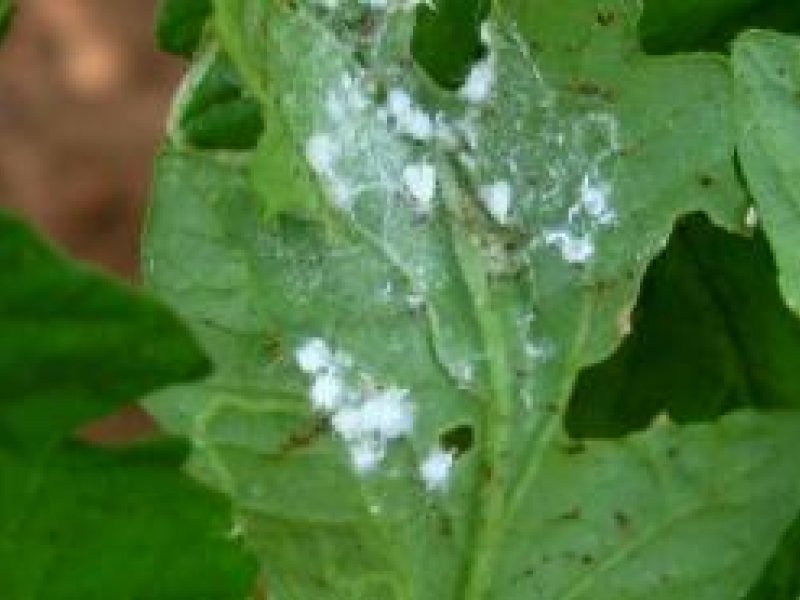|
Fruit borers (Helicoverpa armiguera, Spodoptera littoralis) Fruit borers such as the African bollworm (Helicoverpa armigera) and leaf-eating caterpillars such as the cotton leafworm (Spodoptera littoralis) attack the developing and mature fruit of tomato. The African bollworm, also known as the tomato fruit worm, is one of the most destructive insect pests of tomato, causing yield losses as high as 70% due to fruit boring. They usually bore into the fruit from the stem end, and feed on the inner parts of the fruits, causing extensive fruit damage and promoting decay caused by secondary infections.
They prefer green fruit. Caterpillar of the cotton leaf worm feeds on the leaves of tomato and bores into the fruit, especially those growing down the plant near to the soil. They are olive-green, dark grey or brown in colour with large, black, triangular spots on their back. The fully-grown caterpillars are 3 to 5 cm long. The eggs are laid in batches in one or more layers, usually on the underside of the leaves and covered with hairs. Both caterpillars have many natural enemies such as predatory ants, spiders, damsel and robber flies, and parasitic wasps and flies |
|
|
What to do:
|
|
Anthracnose (Colletotrichum coccodes) Spots of fruits are sunken. When weather is moist, the spots get tan-coloured (growth of fungal spores). There may be several spots on affected fruit and they may join up and cover the whole fruit. Severely affected fruits drop. Eventually, affected fruits dry and become black. Most often, soft-rot bacteria invade affected fruits and cause a soft watery decay. The fungus usually attacks fruits on plants that are weakened or over-ripe. Infection is favoured by relative humidity close to 100% and temperatures between 21 and 300C. |
|
|
What to do:
|
|
Aphids (Aphis gossypii, Myzus persicae) Aphids such as cotton aphid (Aphis gossypii) and the green peach aphid (Myzus persicae) suck plant sap, which can reduce plant growth; they also secrete honeydew, on which sooty moulds growth. Sooty mould on fruits reduces their market value. These aphids may also transmit virus diseases during feeding such as the cucumber mosaic virus. In Kenya, aphids are occasionally found on tomatoes, but they are not considered an important pest. |
|
|
What to do:
|
|
Bacterial canker (Clavibacter michiganensis subsp. michiganensis) The first symptoms are yellowing, curling and wilting of the leaflets, often on one side of the leaf. The affected leaflets turn brown and dry but remain attached to the plant. The whole plant may also show a one-sided disease development. Long brown strips may appear on stems and shoots. These strips dry and crack open to form cankers from which the disease gets its name. When an affected stem is cut lengthwise, there is a creamy white, yellow or reddish-brown line inside the woody tissue. The pith is easily separated from the wood along this line.
The vascular bundles within the pith are destroyed and cavities are formed in the pith. Young affected fruits are small, deformed and seeds are aborted. Also spots may develop on older fruits. These spots are circular, up to three mm wide, with slightly raised brown centre surrounded by a pronounced white halo resembling a 'bird's eye". The halo is flat. The bacterium is seed-borne and can survive up to three years in soil in crop debris. Spread within a crop is by rain splash, sprinklers and pruning knives. |
|
|
What to do:
|
|
Bacterial spot (Xanthomonas campestris pv. vesicatoria) It is another serious disease, occurring during the rainy season. It is most noticeable on fruits, but also causes damage to the foliage and stems. On green fruits, the initial spot is very small and water soaked. It eventually enlarges to about 6 mm. As the bacterial spot matures, it becomes brown and scabby without extending deep into the fruit. On foliage, irregular greasy, dark green spots, 2 to 3 mm wide, are observed. The spots eventually dry and the tissue often tears. The disease is transmitted through the seed. |
|
|
What to do:
|
|
Bacterial wilt (Ralstonia solanacearum) Bacterial wilt has often been reported as the most serious handicap for tomato in the tropics. The disease causes rapid wilting and death of the entire plant without any yellowing or spotting of leaves. Total collapse of the plant usually occurring when temperatures reach 320C and above. Plant wilts while still green. When the stem of a wilting plant is cut across, the pith has a darkened water-soaked appearance, and on squeezing the cut stem, a white, yellow or greyish, slimy exudate may appear. In later stages of the disease, decay of the pith may cause extensive hollowing of the stem. |
|
|
What to do:
|
|
Blossom-end rot It is caused by calcium deficiency and irregular watering. The disease occurs at the blossom-end of the fruit. It starts as a water-soaked spot that enlarges to become dark brown and sunken. The surface of the spot becomes dark and leathery. The rot is dry. |
|
|
What to do:
|
|
Cabbage looper (Trichoplusia ni) In addition to the cotton leaf worm (see fruit borers), other caterpillars such as the cabbage looper (Trichoplusia ni) feed on tomato leaves. However, generally they are not of economic importance.
The cabbage looper is a green caterpillar with faint white stripes along the body. Caterpillars are about 3.5 to 4 cm long when fully-grown. As they move, they arch their back in a looping fashion, hence the common name looper. Larvae (caterpillars) chew holes in the leaves, and larger caterpillars consume great amounts of plant material.
The adult is a moth, about 2.5 cm in length and mottled, greyish-brown. |
|
|
What to do:
|
|
Cutworms (Agrotis spp) Cutworms are the caterpillars of certain moths. They are serious pests of tomato seedlings. They cut stems of newly transplanted or emerged plants at the base. Cutworm damage is more critical after thinning or transplanting. |
|
|
What to do:
|
|
Damping-off diseases (Pythium spp. and Rhizoctonia solani) Damping-off can occur when seedlings die before they have pushed through the soil, resulting in patches that appear to have germinated poorly. Alternatively, seedlings may emerge but fall over and die some time afterwards. The base of stem of affected seedlings become wet and brown. These disease-causing fungi are common in moist soils. They can also be transmitted on seeds. |
|
|
What to do:
|
|
Early blight (Alternaria solani) Leaf spots of early blight are circular, up to 12 mm in diameter, brown, and often show a circular pattern, which distinguishes this disease from other leaf spots on tomato. |
|
|
What to do:
|
|
Fusarium wilt (Fusarium oxysporum sp. Lycopersici) The lower leaves of the plant usually turn yellow and die. One or more branches may exhibit such symptoms. Leaflets on one side may be affected while those on the other side are symptomless. Diseased leaves readily break away from the stem. When affected stems just above ground level and petioles are cut diagonally, a reddish-brown discolouration of the water conducting tissues will be observed. The fungus is both seed- and soil-borne. It causes most damage on light, sandy soils. It is most active at temperatures between 25 and 320 C. The fungus can survive in the soil indefinitely even when no tomatoes are grown. It can also survive in fibrous roots of weeds (e.g. Amaranthus, Digitaria and Malva species). Acidic soils (pH 5.0 to 5.6) and excessive nitrogen fertilisation promote disease development. Infestation by root-knot nematodes encourages the disease. |
|
|
What to do:
|
|
Late blight (Phytophthora infestans) Symptoms of late blight are irregular, greenish-black, water soaked patches, which appear on the leaves. The spots soon turn brown and many of the affected leaves wither, yet frequently remain attached to the stem. Infection of the fruit occurs at any stage of growth. It is most common on the upper half of the fruit. The spots are greasy brown and have a firm corrugated (rough) surface that occasionally shows narrow zonate markings. |
|
|
What to do:
|
|
Leaf mould (Mycovellosiella fulva) Symptoms of leaf mould are pale-green or yellowish areas with undefined margins that appear on the upper leaf surface. Under humid conditions the lower leaf surfaces of the spots become covered by an olive-green to greyish-purple velvety growth of the fungus. |
|
|
What to do:
|
|
Leafminers (Liriomyza spp.) Leafmining flies make tiny punctures on the side of tomato leaves when feeding and laying eggs. These punctures may serve as entry point for disease causing organisms such as bacteria and fungi. The most destructive stages are the immature stages (maggots). Maggots measure up to 3 mm in length. The maggots feed on leaf tissue inside the leaf leaving a wandering track in the form of irregular mines. Heavy mining of leaves may reduce photosynthesis affecting development of flowers and fruits. Heavy attack may cause leaf drop. This is particularly serious for tomato seedlings which may die due to defoliation. Defoliation of tomato plants may also expose fruits to sunburn and affect the market value. Leafminers attack a wide range of cultivated vegetables. |
|
|
What to do:
|
|
Powdery mildew (Leveillula taurica) The spots of powdery mildew appear on older leaves and are light chlorotic to bright yellow. These spots later run together and become necrotic. Whole leaf blades may collapse and dry up. On the upper leaf surface of green leaves, a fine talcum-like powder is observed. This is fungal growth. |
|
|
What to do:
|
|
Root-knot nematodes (Meloidogyne spp.) Root-knot nematodes are very destructive to tomatoes. Damage is most serious on light sandy soils in furrow-irrigated crops. The nematodes cause small lumps known as root knots or galls on the roots. Heavily infected roots are severely distorted and swollen. In time the roots rot. The affected plants are either stunted or have tendency to wilt or even die in hot weather. The affected plants, in most cases, just wilt with the foliage still green - without yellowing. The nematode problem is primarily due to improper crop rotation. |
|
|
What to do:
|
|
Spider mites (Tetranychus spp.) Spider mites are important pests of tomatoes. They are more prevalent in dry areas. Infested leaves show a white to yellow speckling and then turn pale or bronzed. High spider mite infestation causes defoliation, which leads to production of smaller fruits with lower content of ascorbic acid (vitamin C). Spider mite feeding on fruits causes speckling of the fruits.
The tobacco spider mite Tetranychus evansi, is one of the most damaging spider mites on tomato. This spider mite can kill plants very rapidly under hot and dry conditions. Plants with high numbers of this mite can be covered with webbing and an orange cloud of mites. |
|
|
What to do:
|
|
Thrips (Thrips tabaci, Frankliniella occidentalis, F. schultzeii and Ceratothripoides brunneus) Thrips may also be a problem in tomatoes in Kenya. Thrips are small (about 1 to 2 mm long). They usually feed on the lower surface of leaves puncturing them and suck the exuding sap. They also attack buds, flowers and fruits. Attacked leaves have a silvery sheen and show small black spots (thrips excrements). Under heavy infestation attacked buds, and flowers usually fall off. Attacked fruits show speckling and small necrotic patches on the surface affecting fruit quality. Fruits may become deformed. Thrips feed on tomatoes at all stages, but their feeding on seedlings is particularly damaging. Heavy infestation can reduce stands of young seedlings in hot weather. Thrips of the genus Thrips and Frankliniella are vectors of viruses such as the Tomato Spotted Wilt Virus (the most economically important virus in tomato production) and the Tomato Chlorotic Spot Virus. |
|
|
What to do:
|
|
Tomato mirid bug (Nesidiocoris tenuis) It is slender, greenish in colour with a dark brown tint on the forewings. Eggs are laid singly on the growing points, petioles and stems of the tomato plant. The young bugs (nymphs) resemble the adults, but initially have no wings. Older nymphs have wing pads. The tomato bug feed on stems, leaves and flowers of tomatoes, but prefer young leaves and growing points. Sucking by nymphs and adults results in the formation of brownish rings on stems, petioles, growing points and leaf veins, which become brittle. Repeated feeding by the bugs cause crinkling (rolling, puckering and unevenness) of leaves.
Attacked stem bases become swollen with narrow brownish rings at the apices of the swollen areas. Shedding of flowers may be partly due to feeding by this bug. Other major crops attacked include eggplant, sesame and bottle gourds. The tomato bug also exhibits predatory habits, and has been reported preying on other insect pests, such as aphids, jassids (leafhoppers), caterpillars and whiteflies. It has been identified as an important predator of eggs and young caterpillars of the African bollworm and a potential control agent of whiteflies in Europe. This bug was found frequently and in large numbers on tomatoes, throughout NE and NW Somalia (Seif et al. 2003). It has also been reported as a tomato pest in Ghana (Youdeowei, 2002). In Kenya, large numbers of this bug have been observed in tomato fields under heavy and frequent spraying of synthetic pyrethroids. |
|
|
What to do:
|
|
Tomato Mosaic Virus Affected plants show light and dark green mottling and distortion of the youngest leaves. The latter may be stunted or elongated resembling fern leaves. Under high temperature and light intensity, mottling can be severe. Under low temperature and low light intensity, stunting and leaf distortion are severe. Internal browning of the fruit sometimes occurs; this symptom is most common when fruits become infected at mature green or pink stage.
The disease can be seed-borne but can also survive on plant debris in the soil and so re-infect newly planted crops. The virus is easily mechanically transmissible by contact between plants or through human activities (transplanting seedlings or pruning). |
|
|
What to do:
|
|
Tomato russet mite (Aculops lycopersici) They are very tiny, approximately 0.2 mm long, and cannot be seen with the naked eye. They are yellowish, brown or pink. They have a ringed conical body with the head and two pairs of legs at the large end. They complete the lifecycle in 1 week; this explains the rapid increase of this mite in tomato fields. They prefer high temperatures and low humidity. They feed on all above-ground parts of the tomato plant, causing spotting, twisting or folding of leaves and fine cracks on the fruits. Attacked leaves and stems develop a greasy appearance and turn bronzed. The plants can drop their leaves, especially in hot weather. Fruits are then exposed to sunburn. Damage to the plant typically begins near the ground and spreads upwards. Damage can develop very rapidly, and the mites can kill plants in a few days in dry hot weather. Since the mite cannot be seen, the symptoms are easily confused with diseases. The small size of the mites makes monitoring difficult. The first signs of mite presence are the curling and bronzing of the lower leaves of the stem. |
|
|
What to do:
|
|
Tomato spotted wilt virus The virus is transmitted by thrips (Thrips tabaci and Frankliniella spp.). The virus has a wide host range including many ornamental plants, vegetable crops and weeds. Diseased leaves have purplish-brown spots. Diseased leaves later turn brown, die and droop. Brown streaks occur on leaf petioles and stems. Infected plant becomes dwarfed, and with its drooping leaves, it resembles a plant affected by wilt. Symptoms on fruits consist of circular zones with shades of yellow or brown alternating with green and later with pink or red. Fruit symptoms are very characteristic of the disease. |
|
|
What to do:
|
|
Tomato yellow leaf curl virus The virus is transmitted by Whiteflies (Bemisia tabaci). It is not seed-borne. Tomato plants infected early in the season are normally stunted and excessively branched. Affected leaves are chlorotic and are curled upward. Flower drop is common, and therefore, infected plants have a reduced number of flowers and fruits. |
|
|
What to do:
|
|
Tuta absoluta (tomato leaf miner) Tuta absoluta is a new insect pest of tomato plant in sub Saharan Africa. The moth pest originated from Peru and has spread to Europe, Africa and Asia. In Africa, T. absoluta was detected in Tunisia (2009), Ethiopia (2012), Senegal (2013), Sudan (2010) , Tanzania and Kenya (2014) and in Uganda (2015). Although tomato plant is the main host for T. absoluta, the pest also attacks other plants in the Solanacea family including potato, nightshade, eggplant, pepino, tobacco and solanaceous weeds such as Datura. The life cycle of T. absoluta is completed within 30-35 days. T. absoluta can have 10-12 generations per year. Females can lay up 250-300 eggs on host plants. Eggs are small, cylindrical, creamy-white to yellow and approximately 0.35 mm long. Eggs hatch in 4-6 days after egg laying. The larva is cream-colored with a characteristic dark head. T. absoluta has four larval instars. Pupation may take place in the soil, on the leaf surface or within mines. The adults are small moths with 5-7 mm body length. The adults have thread-like antennae and forewings with grey scales and black spots. The larvae feed between the leaf layers causing irregular mines. They eventually tunnel into the stems or burrow into the fruits, leaving black frass as it tunnels. T. absoluta is a very challenging pest to control because of its fast reproductive rate (10 -12 generations per year), short life cycle, nocturnal adults, and concealed larval stage inside the plant parts. It can cause up to 100% loss of tomato fruits if left uncontrolled. |
|
|
What to do:
|
|
Weeds Soil solarisation can provide control of many soil-borne diseases, nematodes, and weeds. Preventing weeds from producing seed helps reduce weed populations in subsequent crops; this also applies to areas adjacent to the cropped fields. A soil cap (5 to 10 cm mound of soil) over the seedline at planting can reduce the first flush of weeds competing with the crop seedlings. The cap is removed just after tomato seedlings germinate, but before rapid elongation of the hypocotyls. This mound also reduces soil moisture loss and emergence problems that result from soil crusting after periods of rainfall, and is formed by disks or other implements.
When tomato seedlings are about 10 cm tall, cultivation can create a dry layer of soil (dry mulch) on the seedline to prevent weed seeds from germinating and to smother small weeds that have already emerged. Flaming is also used for weed control in large-scale commercial tomato production. |
|
|
What to do:
|
|
Tobacco whitefly (Bemisia tabaci) Tobacco whitefly is a serious pest of tomatoes. Whiteflies attack tomatoes from seedling to mature stage. They suck sap from the leaves, and may weaken the plants. Feeding of whiteflies cause yellowing of infested leaves. Immature stages (nymphs) produce honeydew on which sooty mould grows. Heavy honeydew or mould coating reduces plant growth and fruit quality.
The main damage caused by whiteflies is indirect as vectors of virus diseases. Bemisia tabaci transmits several virus diseases in tomato. In particular it is an efficient vector of the Tomato Yellow Leaf Curl Virus (TYLCV), a major disease in Kenya.
Small numbers of whiteflies do not cause major direct plant damage. However, even small numbers of whiteflies may need to be controlled in areas where TYLCV is common. |
|
|
What to do:
|
Geographical Distribution in Africa
Geographical distribution of Tomato in Africa. Updated on 4 July 2019. Source FAOSTAT
General Information and Agronomic Aspects
Tomatoes are native to South and Central America, and are now cultivated widely throughout the world.
Tomatoes are one of the most widely cultivated vegetable crops in Africa. They are grown for home consumption in the backyard of almost every homestead across sub-Saharan Africa. They are important source of vitamins and an important cash crop for both smallholders and medium-scale commercial farmers. Tomatoes acting as taste enhancers in food are always in high demand both for fresh consumption and processing.
Tomato yields in smallholder cropping systems in the region are generally far below the potential of the crop. Average yields as low as 7 tons/ha have been reported from Tanzania and 10 tons/ha from Uganda, while yields as high as 100 tons/ha have been recorded from commercial farmers in Zimbabwe. There are several reasons for low yields. Among these are low quality seeds, non-availability of inputs, sub-optimum crop husbandry and a large number of pests and diseases.
Cherry Tomatoes are a fast expanding export crop in Kenya. These are miniature tomatoes with a preferred size of around 15 g per fruit. Cherry tomatoes are easier to grow organically than most other tomatoes as many of them have a high tolerance to diseases and can be grown successfully both under green house and open field conditions.
Nutritive Value per 100 g of edible Portion
| Raw or Cooked Tomato | Food Energy (Calories / %Daily Value*) |
Carbohydrates (g / %DV) |
Fat (g / %DV) |
Protein (g / %DV) |
Calcium (g / %DV) |
Phosphorus (mg / %DV) |
Iron (mg / %DV) |
Potassium (mg / %DV) |
Vitamin A (I.U) |
Vitamin C (I.U) |
Vitamin B 6 (I.U) |
Vitamin B 12 (I.U) |
Thiamine (mg / %DV) |
Riboflavin (mg / %DV) |
Ash (g / %DV) |
| Red Tomato cooked | 18.0 / 1% | 4.0 / 1% | 0.1 / 5% | 0.9 / 2% | 11.0 / 1% | 28.0 / 3% | 0.7 / 4% | 218.0 / 6% | 489 IU / 10% | 22.8 / 38% | 0.1 / 4% | 0.0 / 0% | 0.0 / 2% | 0.0 / 1% | 0.6 |
| Green Tomato raw | 23.0 / 1% | 5.1 / 2% | 0.2 / 0% | 1.2 / 2% | 13.0 / 1% | 28.0 / 3% | 0.5 / 3% | 204 / 6% | 642 IU / 13% | 23.4 / 39% | 0.1 / 4% | 0.0 / 0% | 0.1 / 4% | 0.0 / 2% | 0.5 |
| Orange Tomato raw | 16.0 / 1% | 3.2 / 1% | 0.2 / 0% | 1.2 / 2% | 5.0 / 1% | 29.0 / 3% | 0.5 / 3% | 212 / 6% | 1496 IU / 30% | 16.0 / 27% | 0.1 / 3% | 0.0 / 0% | 0.0 / 3% | 0.0 / 2% | 0.7 |
| Yellow Tomato raw | 15.0 / 1% | 3.0 / 1% | 0.3 / 0% | 1.0 / 2% | 11.0 / 1% | 36.0 / 4% | 0.5 / 3% | 258.0 / 7% | 0.0 IU / 0% | 9.0 / 15% | 0.1 / 3% | 0.0 / 0% | 0.0 / 3% | 0.0 / 3% | 0.5 |
*Percent Daily Values (DV) are based on a 2000 calorie diet. Your daily values may be higher or lower, depending on your calorie needs.
Climate conditions, soil and water management
Ideally, tomato requires a relatively cool, dry climate for high yield and premium quality. However, it is adapted to a wide range of climatic conditions. Tomatoes have been grown as far north as the Arctic Circle (under protection) and down to the hot and humid equator. The optimum temperature range for growth and development is 21 to 24°C. Prolonged exposure to temperatures below 12°C can cause chilling injury. Mean temperatures above 27°C severely impair growth and fruit set. Destruction of pollen and egg cells occurs when the maximum day-time temperature is 38°C or above for 5 to 10 days. Fruit set is also generally poor if the night temperatures are above 21°C just before and after flower formation. Hot dry winds can also cause flower abortion. Tomatoes are not sensitive to day length and set fruits in photoperiods ranging from 7 to 19 hours. Tomatoes can be grown in many soil types ranging from sandy loam to clay-loam soils that are rich in organic matter. The ideal soil pH range is 6 to 6.5; higher or lower pH can cause mineral deficiencies or toxicities. Long periods of flooding are detrimental to tomato growth and development.
Small-holder farmer tomato seed production
For own seed production it is not recommended to use hybrid varieties. These varieties carry a label "F1". However, if a hybrid variety is preferred, it cannot be used for more than one generation (one crop cycle).
Conditions to be followed when producing seed:
- The tomato seed should be multiplied only once.
- Buffer zone for tomato seed plot should be 25 m from any other tomato crop.
- The plot should not previously have had tomatoes planted recently.
- The tomato crop should be scouted regularly for pests and diseases.
- The first step fruits should not be included for seed extraction.
- After planting the seed the off types should be uprooted early as when seen.
- Weeding of plot should be properly done.
- Proper crop management is needed i.e. fertiliser application, pruning, staking irrigation etc.
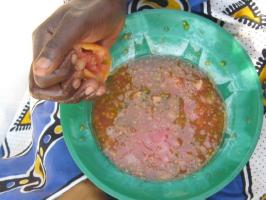 |
Seed extraction process
|
| Tomato seed extraction by smallholder farmers | |
|
© A.A. Seif, icipe |
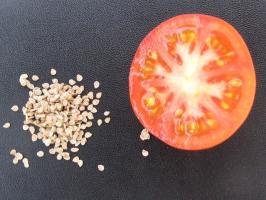 |
| Locally produced tomato seed |
|
© A.A. Seif, icipe |
- Stir the seeds daily to ensure uniform fermentation and to prevent seed discolouration.
- Wash the fermented seeds in clean water. Any seeds that float during washing should be discarded because they are either not fully ripened or filled properly.
- Dry the seeds in indirect light and in well-ventilated places. The seeds could be spread out over a clean manila sack to dry.
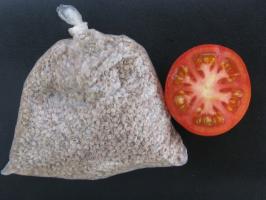 |
In case seeds cannot be sown immediately, they should be stored in a waterproof container (transparent plastic bag / non-coloured glass bottle). Transparent materials allow sunlight, which reduces mould development. Place a bit of ashes in the bottom of the container to absorb any moisture and to prevent the seeds from moulding. In case where pots or bottles are used for seed storage, the tops should be covered with plastic film to stop possible water seepage and mite infestation.
Seeds can be stored, if properly dried, up to 2 years. (This information is based on a Biovision Project carried out in Taita Hills, Kenya, under Eastern Arc Mountains in conjunction with Wild Life Services) |
| Storage of locally produced tomato seeds in plastic bag | |
|
© A.A. Seif, icipe |
Propagation and planting
Tomatoes can be direct-seeded or transplanted in the field, but this method is expensive as large amounts of seed are required (about 500 to 1000 g of seeds/ ha) and adds about four weeks of weeding labour to growing costs. In contrast, raising the young transplants in a special nursery enables growers to achieve great seedling uniformity, requires smaller quantity of seed and saves on weeding costs.
Nursery bed preparation:
- Construct raised seedbeds of maximum one m width in a place where no potatoes, tomatoes, eggplants or peppers have been grown for about 3 years.
- Incorporate about 5 kg of good compost/ m² into the seedbeds, which are finely cultivated on top.
- Drill shallow seeding furrows with a pointed stick. One ha of tomatoes requires 150 to 200 g of well germinating seed.
- Sow seeds in the furrows and cover them lightly with soil.
- Pat firmly with the flat side of a rake or similar tool, mulch and water liberally.
- Never use fresh manure on a seed bed as it will burn young seedlings.
- After emergence of seedlings push away the mulch from the rows to allow sunlight to get through to the young seedlings.
- Individual plant raising in banana leaf pots or plastic seedling trays will greatly improve eventual plant establishment, by reducing transplanting shock and root damage during transplanting.
- The young seedlings require sufficient water to sustain good, healthy growth.A week before transplanting, reduce watering to harden the seedlings. Three- to four-week-old seedlings (15 to 25 cm high with 3 to 5 true leaves) are ready for transplanting. Seedlings must be thoroughly watered 12 to 14 hours before they are lifted out of the seedbed, to avoid excessive damage to the roots. Transplant seedlings in the afternoon or on a still, cloudy day to reduce the transplanting shock, and water them immediately. As little as a cup of water per plant immediately at planting will greatly speed up plant establishment.
- Spacing between plants and distance between rows depends on the cultivar's growth habit and whether the plants are to be supported by stakes or left to grow on the ground.
- Indeterminate varieties are generally staked while determinate varieties can be grown in the field without staking. Common configurations are plants spaced 30 to 60 cm apart in single or double rows on 1.0 to 1.4 m wide beds.
Common Varieties available in Kenya and their yield potential
Table: Common tomatoe varieties available in Kenya and their yield potential
|
Varieties for processing |
Yield potential (tonnes/ha) |
|
"Roma VF" |
83 |
|
"Sun Marzano" |
100 |
|
"Rutgers 10x Hybrid" |
100 |
|
"Heinz 1350" |
60 |
|
"Roma Nova" |
100 |
|
"Cal J" |
73 |
| "M-82" | 57 |
| "Riogrande" | 49 |
|
Varieties for Fresh Market |
Yield potential (tonnes/ha) |
|
"Prostar F1" |
49 |
|
"Money Maker" |
20-50 |
|
"Early Beauty" |
25 |
|
"Super Marmande" |
85 |
|
"Ponderosa" |
90 |
|
"Hot Set" |
40 |
|
"Best of all" |
100 |
|
"Marglobe" |
90 |
|
"BWN 21" |
90 |
|
"Kenton F1" |
32 |
|
"Zawadi" |
30 |
|
"New Fortune Maker" |
35 |
Table: Some varieties reported to be tolerant (T) or resistant (R) to pests and diseases available in East, Central and Southern Africa
| Variety | Bacterial wilt | Early blight | Fusarium and Verticilium wilt | Late blight | Red spider mites | Root-knot nematodes | Tomato Mosaic Virus | Tomato Yellow Leaf Curl Virus |
| "Alboran" | - | - | - | T | - | - | - | - |
| "Fortune Maker" | R | - | R | - | - | - | - | - |
| "Kentom" | R | - | - | - | - | R | R | - |
| "Meru" | - | - | - | R | - | - | R | - |
| "Rio Grande" | - | R | R | R | - | - | - | - |
| "Roma VF" | - | - | R | - | - | - | - | - |
| "Roma VFN" | - | - | R | - | R | R | - | - |
| "Shengena" | - | - | - | R | - | R | R | - |
| "Taiwan F1" | R | - | - | - | - | - | - | - |
| "Tengeru 97" | - | - | R | R | - | R | R | R |
The breeding of tropical cherry tomato lines has been done by World Vegetable Centre in Taiwan. All varieties available in Kenya so far are indeterminate and take 65 to 72 days to yield from date of transplanting. Cherry Tomatoes can typically produce for longer seasons than ordinary tomatoes due to their disease resistance or tolerance. The cultivars "Sugar Pearl" and "Girls Sweet" produce fruit that are prone to fruit cracking, so preferred varieties include "Tiny Tim", "Super Sweet 100F1", "Cherry King F1", "Cherry Sweet 100F1", "Sweetie" etc. Note that varieties with the added F1 on their name are hybrids, and seed collection from these may not produce as well as the bought seed. However "Tiny Tim" and "Sweetie" are open pollinated, and farmers could propagate seed from the best plants with good results.
Husbandry
Tomatoes respond very well to liberal amounts of well-rotted compost or manure. In addition a spoonful (or 3 teaspoons) of rock phosphate should be added to each planting hole. If the soil is poor in organic matter it is advisable to grow a crop of good quality green manure such as cowpeas, mucuna, soybean, or crotalaria before transplanting tomato seedlings. Avoid commercial nitrogen fertilisers as excess nitrogen is associated with fruit puffiness and blossom-end rot, and generally causes excessive vegetative growth. Excess free nitrogen in the soil also causes softer leaves and makes the plants attractive to pests and diseases. Competition with weeds, especially in the hot and humid tropics, can be very severe. To control weeds on open land crops, slash regularly emerging weeds as close to the ground as possible between rows of tomatoes is recommended. Leave slashed weeds on the soil as mulch to help prevent erosion, reduce soil temperature and conserve soil moisture. This should be supplemented by manual weeding in rows and mulching the beds with straw.
Staking:
For tall growing indeterminate varieties, put a 2 m stake firmly in the ground for each tomato plant and tie the stems loosely as the plant grows. Alternatively put a stout pole in the ground at every four m and two wires run - 1 at 2 m and another one at 0,15 m above the ground. Tye a fairly strong string between the two wires behind each tomato plant. The plants can then be carefully twisted around the strings as they grow.
Pruning of tomato plants is necessary for indeterminate varieties. One or two main stems should be allowed to grow and the side branches (laterals) pinched off as the crop grown on a weekly basis. When 6 to 8 flower clusters are formed, the growing top should be pinched off to encourage the growth of good size marketable fruit. Leaves close to the ground should be removed to help prevent entry of blight infection. No pruning and regulation of fruit number and clusters are normally practised on determinate cultivars. Semi-determinate cultivars may be grown either as a determinate or indeterminate crop. Smokers should wash their hands carefully with soap before handling tomato plants as they may otherwise transmit tobacco mosaic virus disease.
Tomatoes need adequate irrigation during the early plant growth, fruit set and fruit enlargement stages. Consistency of water supply to the plants plays a major role in attaining uniform maturity. It also reduces the incidence of blossom-end rot, a physiological disorder normally attributed to calcium deficiency during fruit enlargement. In dry weather watering is essential at least two times a week. Drip irrigation is the most efficient and risk free method of irrigation, as it does not create water splashes onto the plants.
Cherry tomatoes although indeterminate can produce quite well even when not staked in the field, but must then be given adequate space as they spread quite extensively ( one m² per plant is minimum). Higher production and easier field management are benefits of the expensive staking procedure.
Harvesting
Fresh-market tomatoes are often harvested at the mature-green stage and ripened in transit or in storage before they are marketed. Ethylene is sometimes used to rapidly and uniformly ripen mature-green tomatoes prior to shipping them to the market, but this adversely affects quality. This is not a common practice in Kenya. Generally, tomatoes harvested at pre-ripe stages tend to be of lower quality (lower soluble solids, ascorbic acid and reducing sugars) than plant-ripened tomatoes. The nature of the growth and ripening pattern of fresh-market tomato cultivars require frequent pickings for either mature-green or plant-ripe fruits. In contrast to the fresh-market or table tomatoes, processing tomatoes are picked fully ripe. In developed countries, harvesting is often by machine. Tomatoes used for pureed products such as soup, juice and sauces, are left on the plant until over 85% of the fruits are ripe. Those for whole tomatoes are picked while still firm, but often only 65% of the crop may be ready to be picked all at once.
After picking, tomatoes should be stored in a shady place either in the field or at home to prepare them for the market. Properly sorted and graded fruits generally command a better market price than ungraded fruits. The marketable fruits are then packaged in suitable containers, often 20-kg wooden boxes, bamboo baskets, plastic boxes, or other locally available packaging materials. Proper packaging protects fruits from injury and reduces water loss. The storage life of tomatoes depends on the maturity stage at which they are harvested and on the desired quality of fruits. Quality is highest when completely ripe, whether artificially or on the plant. Ideally mature-green tomatoes should be stored for 7 to 10 days at 13 to 18°C at 85 to 90% RH so that they will ripen properly. Colour is the single most important visual parameter of tomato quality. Lycopene development at temperatures above 30°C is generally poor. This is the main reason that tomatoes grown in the hot tropics tend to have a pale red or yellowish colour and are poorly flavoured.
Harvesting and packaging of cherry tomatoes depend on market requirements. For distant markets, the fruit clusters may be cut when the fruits start turning to a red or pink colour depending on the cultivar. Firm red ripe fruits are required for the domestic market. However for the export market, cherry tomatoes are graded and packaged into pre-packs before shipment direct to supermarkets in the export destinations. On the whole a marketable yield of 20 tons /ha and above is considered a good yield. Yield of up to 60 tons/ha have been obtained under experimental conditions at KALRO,Thika Horticultural Research Station.
Fresh Quality Specifications for the Market in Kenya
The following specifications constitute raw material purchasing requirements.
 |
| Fresh quality specifications for cherry tomatoes |
|
© S. Kahumbu, Kenya
|
Information on Pests and Weeds
The main tomato pests in east and southern Africa are red spider mites and russet mites, fruitworms, whiteflies, leafminers and thrips.
Examples of Tomato Pests and Organic Control Methods
| Cutworms are the caterpillars of certain moths. They are serious pests of tomato seedlings. They cut stems of newly transplanted or emerged plants at the base. Cutworm damage is more critical after thinning or transplanting. What to do:
|
| Aphids (Aphis gossypii, Myzus persicae) Aphids such as cotton aphid (Aphis gossypii) and the green peach aphid (Myzus persicae) suck plant sap, which can reduce plant growth; they also secrete honeydew, on which sooty moulds growth. Sooty mould on fruits reduces their market value. These aphids may also transmit virus diseases during feeding such as the cucumber mosaic virus. In Kenya, aphids are occasionally found on tomatoes, but they are not considered an important pest. What to do:
|
| Root-knot nematodes (Meloidogyne spp.) Root-knot nematodes are very destructive to tomatoes. Damage is most serious on light sandy soils in furrow-irrigated crops. The nematodes cause small lumps known as root knots or galls on the roots. Heavily infected roots are severely distorted and swollen. In time the roots rot. The affected plants are either stunted or have tendency to wilt or even die in hot weather. The affected plants, in most cases, just wilt with the foliage still green - without yellowing. The nematode problem is primarily due to improper crop rotation. What to do:
|
| Tobacco whitefly (Bemisia tabaci) Tobacco whitefly is a serious pest of tomatoes. Whiteflies attack tomatoes from seedling to mature stage. They suck sap from the leaves, and may weaken the plants. Feeding of whiteflies cause yellowing of infested leaves. Immature stages (nymphs) produce honeydew on which sooty mould grows. Heavy honeydew or mould coating reduces plant growth and fruit quality.
The main damage caused by whiteflies is indirect as vectors of virus diseases. Bemisia tabaci transmits several virus diseases in tomato. In particular it is an efficient vector of the Tomato Yellow Leaf Curl Virus (TYLCV), a major disease in Kenya.
Small numbers of whiteflies do not cause major direct plant damage. However, even small numbers of whiteflies may need to be controlled in areas where TYLCV is common. What to do:
|
| Thrips (Thrips tabaci, Frankliniella occidentalis, F. schultzeii and Ceratothripoides brunneus) Thrips may also be a problem in tomatoes in Kenya. Thrips are small (about 1 to 2 mm long). They usually feed on the lower surface of leaves puncturing them and suck the exuding sap. They also attack buds, flowers and fruits. Attacked leaves have a silvery sheen and show small black spots (thrips excrements). Under heavy infestation attacked buds, and flowers usually fall off. Attacked fruits show speckling and small necrotic patches on the surface affecting fruit quality. Fruits may become deformed. Thrips feed on tomatoes at all stages, but their feeding on seedlings is particularly damaging. Heavy infestation can reduce stands of young seedlings in hot weather. Thrips of the genus Thrips and Frankliniella are vectors of viruses such as the Tomato Spotted Wilt Virus (the most economically important virus in tomato production) and the Tomato Chlorotic Spot Virus. What to do:
|
| Leafmining flies make tiny punctures on the side of tomato leaves when feeding and laying eggs. These punctures may serve as entry point for disease causing organisms such as bacteria and fungi. The most destructive stages are the immature stages (maggots). Maggots measure up to 3 mm in length. The maggots feed on leaf tissue inside the leaf leaving a wandering track in the form of irregular mines. Heavy mining of leaves may reduce photosynthesis affecting development of flowers and fruits. Heavy attack may cause leaf drop. This is particularly serious for tomato seedlings which may die due to defoliation. Defoliation of tomato plants may also expose fruits to sunburn and affect the market value. Leafminers attack a wide range of cultivated vegetables. What to do:
|
| Fruit borers (Helicoverpa armiguera, Spodoptera littoralis) Fruit borers such as the African bollworm (Helicoverpa armigera) and leaf-eating caterpillars such as the cotton leafworm (Spodoptera littoralis) attack the developing and mature fruit of tomato. The African bollworm, also known as the tomato fruit worm, is one of the most destructive insect pests of tomato, causing yield losses as high as 70% due to fruit boring. They usually bore into the fruit from the stem end, and feed on the inner parts of the fruits, causing extensive fruit damage and promoting decay caused by secondary infections.
They prefer green fruit. Caterpillar of the cotton leaf worm feeds on the leaves of tomato and bores into the fruit, especially those growing down the plant near to the soil. They are olive-green, dark grey or brown in colour with large, black, triangular spots on their back. The fully-grown caterpillars are 3 to 5 cm long. The eggs are laid in batches in one or more layers, usually on the underside of the leaves and covered with hairs. Both caterpillars have many natural enemies such as predatory ants, spiders, damsel and robber flies, and parasitic wasps and flies What to do:
|
| Spider mites (Tetranychus spp.) Spider mites are important pests of tomatoes. They are more prevalent in dry areas. Infested leaves show a white to yellow speckling and then turn pale or bronzed. High spider mite infestation causes defoliation, which leads to production of smaller fruits with lower content of ascorbic acid (vitamin C). Spider mite feeding on fruits causes speckling of the fruits.
The tobacco spider mite Tetranychus evansi, is one of the most damaging spider mites on tomato. This spider mite can kill plants very rapidly under hot and dry conditions. Plants with high numbers of this mite can be covered with webbing and an orange cloud of mites. What to do:
|
| Tomato mirid bug (Nesidiocoris tenuis) It is slender, greenish in colour with a dark brown tint on the forewings. Eggs are laid singly on the growing points, petioles and stems of the tomato plant. The young bugs (nymphs) resemble the adults, but initially have no wings. Older nymphs have wing pads. The tomato bug feed on stems, leaves and flowers of tomatoes, but prefer young leaves and growing points. Sucking by nymphs and adults results in the formation of brownish rings on stems, petioles, growing points and leaf veins, which become brittle. Repeated feeding by the bugs cause crinkling (rolling, puckering and unevenness) of leaves.
Attacked stem bases become swollen with narrow brownish rings at the apices of the swollen areas. Shedding of flowers may be partly due to feeding by this bug. Other major crops attacked include eggplant, sesame and bottle gourds. The tomato bug also exhibits predatory habits, and has been reported preying on other insect pests, such as aphids, jassids (leafhoppers), caterpillars and whiteflies. It has been identified as an important predator of eggs and young caterpillars of the African bollworm and a potential control agent of whiteflies in Europe. This bug was found frequently and in large numbers on tomatoes, throughout NE and NW Somalia (Seif et al. 2003). It has also been reported as a tomato pest in Ghana (Youdeowei, 2002). In Kenya, large numbers of this bug have been observed in tomato fields under heavy and frequent spraying of synthetic pyrethroids. What to do:
|
| Tomato russet mite (Aculops lycopersici) They are very tiny, approximately 0.2 mm long, and cannot be seen with the naked eye. They are yellowish, brown or pink. They have a ringed conical body with the head and two pairs of legs at the large end. They complete the lifecycle in 1 week; this explains the rapid increase of this mite in tomato fields. They prefer high temperatures and low humidity. They feed on all above-ground parts of the tomato plant, causing spotting, twisting or folding of leaves and fine cracks on the fruits. Attacked leaves and stems develop a greasy appearance and turn bronzed. The plants can drop their leaves, especially in hot weather. Fruits are then exposed to sunburn. Damage to the plant typically begins near the ground and spreads upwards. Damage can develop very rapidly, and the mites can kill plants in a few days in dry hot weather. Since the mite cannot be seen, the symptoms are easily confused with diseases. The small size of the mites makes monitoring difficult. The first signs of mite presence are the curling and bronzing of the lower leaves of the stem. What to do:
|
| Cabbage looper (Trichoplusia ni) In addition to the cotton leaf worm (see fruit borers), other caterpillars such as the cabbage looper (Trichoplusia ni) feed on tomato leaves. However, generally they are not of economic importance.
The cabbage looper is a green caterpillar with faint white stripes along the body. Caterpillars are about 3.5 to 4 cm long when fully-grown. As they move, they arch their back in a looping fashion, hence the common name looper. Larvae (caterpillars) chew holes in the leaves, and larger caterpillars consume great amounts of plant material.
The adult is a moth, about 2.5 cm in length and mottled, greyish-brown. What to do:
|
| Tuta absoluta (tomato leaf miner) Tuta absoluta is a new insect pest of tomato plant in sub Saharan Africa. The moth pest originated from Peru and has spread to Europe, Africa and Asia. In Africa, T. absoluta was detected in Tunisia (2009), Ethiopia (2012), Senegal (2013), Sudan (2010) , Tanzania and Kenya (2014) and in Uganda (2015). Although tomato plant is the main host for T. absoluta, the pest also attacks other plants in the Solanacea family including potato, nightshade, eggplant, pepino, tobacco and solanaceous weeds such as Datura. The life cycle of T. absoluta is completed within 30-35 days. T. absoluta can have 10-12 generations per year. Females can lay up 250-300 eggs on host plants. Eggs are small, cylindrical, creamy-white to yellow and approximately 0.35 mm long. Eggs hatch in 4-6 days after egg laying. The larva is cream-colored with a characteristic dark head. T. absoluta has four larval instars. Pupation may take place in the soil, on the leaf surface or within mines. The adults are small moths with 5-7 mm body length. The adults have thread-like antennae and forewings with grey scales and black spots. The larvae feed between the leaf layers causing irregular mines. They eventually tunnel into the stems or burrow into the fruits, leaving black frass as it tunnels. T. absoluta is a very challenging pest to control because of its fast reproductive rate (10 -12 generations per year), short life cycle, nocturnal adults, and concealed larval stage inside the plant parts. It can cause up to 100% loss of tomato fruits if left uncontrolled. What to do:
|
Information on Diseases
The main diseases affecting tomatoes in the region are early blight, late blight, bacterial wilt, Fusarium wilt, bacterial canker and root-knot nematodes.
Other bacterial diseases of tomato include bacterial speck (Pseudomonas syringae pv. tomato), bacterial stem and fruit rot (Erwinia carotovora subsp. carotovora), and pith necrosis (Pseudomonas corrugata).
Other important fungal diseases of tomatoes are leaf mould (Mycovellosiella fulva) and powdery mildew (Leveillula taurica).
Recent surveys have shown that viral diseases are a major constraint to tomato production in Eastern and Southern Africa. Important virus diseases are Tomato yellow leaf curl virus, and more recently also Tomato spotted wilt virus.
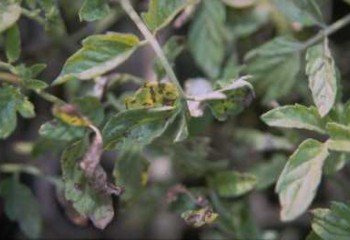
| Anthracnose (Colletotrichum coccodes) Spots of fruits are sunken. When weather is moist, the spots get tan-coloured (growth of fungal spores). There may be several spots on affected fruit and they may join up and cover the whole fruit. Severely affected fruits drop. Eventually, affected fruits dry and become black. Most often, soft-rot bacteria invade affected fruits and cause a soft watery decay. The fungus usually attacks fruits on plants that are weakened or over-ripe. Infection is favoured by relative humidity close to 100% and temperatures between 21 and 300C. What to do:
|
| Bacterial wilt (Ralstonia solanacearum) Bacterial wilt has often been reported as the most serious handicap for tomato in the tropics. The disease causes rapid wilting and death of the entire plant without any yellowing or spotting of leaves. Total collapse of the plant usually occurring when temperatures reach 320C and above. Plant wilts while still green. When the stem of a wilting plant is cut across, the pith has a darkened water-soaked appearance, and on squeezing the cut stem, a white, yellow or greyish, slimy exudate may appear. In later stages of the disease, decay of the pith may cause extensive hollowing of the stem. What to do:
|
| Leaf mould (Mycovellosiella fulva) Symptoms of leaf mould are pale-green or yellowish areas with undefined margins that appear on the upper leaf surface. Under humid conditions the lower leaf surfaces of the spots become covered by an olive-green to greyish-purple velvety growth of the fungus. What to do:
|
| Powdery mildew (Leveillula taurica) The spots of powdery mildew appear on older leaves and are light chlorotic to bright yellow. These spots later run together and become necrotic. Whole leaf blades may collapse and dry up. On the upper leaf surface of green leaves, a fine talcum-like powder is observed. This is fungal growth. What to do:
|
| It is caused by calcium deficiency and irregular watering. The disease occurs at the blossom-end of the fruit. It starts as a water-soaked spot that enlarges to become dark brown and sunken. The surface of the spot becomes dark and leathery. The rot is dry. What to do:
|
| The virus is transmitted by Whiteflies (Bemisia tabaci). It is not seed-borne. Tomato plants infected early in the season are normally stunted and excessively branched. Affected leaves are chlorotic and are curled upward. Flower drop is common, and therefore, infected plants have a reduced number of flowers and fruits. What to do:
|
| The virus is transmitted by thrips (Thrips tabaci and Frankliniella spp.). The virus has a wide host range including many ornamental plants, vegetable crops and weeds. Diseased leaves have purplish-brown spots. Diseased leaves later turn brown, die and droop. Brown streaks occur on leaf petioles and stems. Infected plant becomes dwarfed, and with its drooping leaves, it resembles a plant affected by wilt. Symptoms on fruits consist of circular zones with shades of yellow or brown alternating with green and later with pink or red. Fruit symptoms are very characteristic of the disease. What to do:
|
| Affected plants show light and dark green mottling and distortion of the youngest leaves. The latter may be stunted or elongated resembling fern leaves. Under high temperature and light intensity, mottling can be severe. Under low temperature and low light intensity, stunting and leaf distortion are severe. Internal browning of the fruit sometimes occurs; this symptom is most common when fruits become infected at mature green or pink stage.
The disease can be seed-borne but can also survive on plant debris in the soil and so re-infect newly planted crops. The virus is easily mechanically transmissible by contact between plants or through human activities (transplanting seedlings or pruning). What to do:
|
| Bacterial spot (Xanthomonas campestris pv. vesicatoria) It is another serious disease, occurring during the rainy season. It is most noticeable on fruits, but also causes damage to the foliage and stems. On green fruits, the initial spot is very small and water soaked. It eventually enlarges to about 6 mm. As the bacterial spot matures, it becomes brown and scabby without extending deep into the fruit. On foliage, irregular greasy, dark green spots, 2 to 3 mm wide, are observed. The spots eventually dry and the tissue often tears. The disease is transmitted through the seed. What to do:
|
| Bacterial canker (Clavibacter michiganensis subsp. michiganensis) The first symptoms are yellowing, curling and wilting of the leaflets, often on one side of the leaf. The affected leaflets turn brown and dry but remain attached to the plant. The whole plant may also show a one-sided disease development. Long brown strips may appear on stems and shoots. These strips dry and crack open to form cankers from which the disease gets its name. When an affected stem is cut lengthwise, there is a creamy white, yellow or reddish-brown line inside the woody tissue. The pith is easily separated from the wood along this line.
The vascular bundles within the pith are destroyed and cavities are formed in the pith. Young affected fruits are small, deformed and seeds are aborted. Also spots may develop on older fruits. These spots are circular, up to three mm wide, with slightly raised brown centre surrounded by a pronounced white halo resembling a 'bird's eye". The halo is flat. The bacterium is seed-borne and can survive up to three years in soil in crop debris. Spread within a crop is by rain splash, sprinklers and pruning knives. What to do:
|
| Damping-off diseases (Pythium spp. and Rhizoctonia solani) Damping-off can occur when seedlings die before they have pushed through the soil, resulting in patches that appear to have germinated poorly. Alternatively, seedlings may emerge but fall over and die some time afterwards. The base of stem of affected seedlings become wet and brown. These disease-causing fungi are common in moist soils. They can also be transmitted on seeds. What to do:
|
| Fusarium wilt (Fusarium oxysporum sp. Lycopersici) The lower leaves of the plant usually turn yellow and die. One or more branches may exhibit such symptoms. Leaflets on one side may be affected while those on the other side are symptomless. Diseased leaves readily break away from the stem. When affected stems just above ground level and petioles are cut diagonally, a reddish-brown discolouration of the water conducting tissues will be observed. The fungus is both seed- and soil-borne. It causes most damage on light, sandy soils. It is most active at temperatures between 25 and 320 C. The fungus can survive in the soil indefinitely even when no tomatoes are grown. It can also survive in fibrous roots of weeds (e.g. Amaranthus, Digitaria and Malva species). Acidic soils (pH 5.0 to 5.6) and excessive nitrogen fertilisation promote disease development. Infestation by root-knot nematodes encourages the disease. What to do:
|
| Early blight (Alternaria solani) Leaf spots of early blight are circular, up to 12 mm in diameter, brown, and often show a circular pattern, which distinguishes this disease from other leaf spots on tomato. What to do:
|
| Late blight (Phytophthora infestans) Symptoms of late blight are irregular, greenish-black, water soaked patches, which appear on the leaves. The spots soon turn brown and many of the affected leaves wither, yet frequently remain attached to the stem. Infection of the fruit occurs at any stage of growth. It is most common on the upper half of the fruit. The spots are greasy brown and have a firm corrugated (rough) surface that occasionally shows narrow zonate markings. What to do:
|
Information Source Links
- ACIAR, "Partners in Research for Development" Magazine, Summer 2005/6. www.aciar.gov.au
- AIC (2000). Local and Export Vegetables Growing Manual. Nairobi Kenya
- AIC (2003). Fruits and Vegetables Technical Handbook. Nairobi, Kenya
- AVRDC. Tomato fruitworm. www.avrdc.org
- CAB International (2005). Crop Protection Compendium, 2005 Edition. Wallingford, UK www.cabi.org
- Dobson, H, Cooper, J., Manyangarirwa, W.,Karuma, J. and Chiimba, W. (2002). Integrated Vegetable Pest Management - Safe and sustainable protection of small-scale brassicas and tomatoes. Natural Resources Institute, University of Greenwich, UK ISBN: 0-85954-536-9
- East African Seed Co. Ltd. Africa's Best Grower's Guide www.easeed.com
- Nutrition Data www.nutritiondata.com.
- Seif, A. A., Varela, A. M. and Nyambo, B. (2003). Tomato pests and diseases in Somalia and their control. Edited by A. J. Harberd. Integrated Pest Management Project in Somalia. UNA IPM Project.
- Varela, A.M., Seif, A.A. and Loehr, L. (2003). A Guide to IPM in Tomato Production in Eastern and Southern Africa. ICIPE, Kenya. ISBN: 92 9064 149 5.
- Youdeowei, A. (2002). Integrated pest management practices for the production of vegetables. GTZ. Integrated Pest Management Extension Guide 4. Published by The Ministry of Food and Agriculture (MOFA) Plant Protection and Regulatory Services Directorate (PPRSD), Ghana with the German Development Cooperation (GTZ). ISBN: 9988-0-1088-5.
Contact Information
- Corner Shop Nairobi:cornershop@africaonline.co.ke, +254 (0) 0716 905 486, (20) 2712268/9
- Green Dreams: info@organic.co.ke +254 (0) 724 781 971/ 0722 562 717001
- Horticultural Crops Directorate: info@agricultureauthority.go.ke, +254 20 2536869, 0722 200 556
- Horticultural Research Institute, Thika: director.hri@kalro.org. +254 (20) 2055038,
- Kalimoni Greens: www.kalimonigreens.com , +254 (0) 708 278 273
- Karen Provision Stores:kps@nbi.ispkenya.com +254 20 882 252, 0736 371 437
- Muthaiga Green Grocers, Nairobi
- Nakumatt Supermarket: info@nakumatt.net, +254 (0) 733 632 130, 0722 204 931, (20) 3599991-4
- Uchumi Supermarket: info@uchumi.com +254 20 8020081 - 5, 0733 410 028,
- Zuchinni Green Grocers, Nairobi. +254 (20) 2215067

